A centered hearth feels classic, yet an off-center fireplace can shape a room far more dynamically — inviting layered storage, asymmetrical art displays, and flexible seating that a perfectly balanced wall sometimes stifles. Designers are leaning into this quirk, using built-ins, bold cladding, and clever furniture plans to turn a lopsided firebox into the star of the space. Below you’ll find twenty-five fresh, actionable ways to embrace that off-center fireplace and make the entire room feel intentional, balanced, and irresistibly cozy.
1. Anchor With Staggered Built-Ins
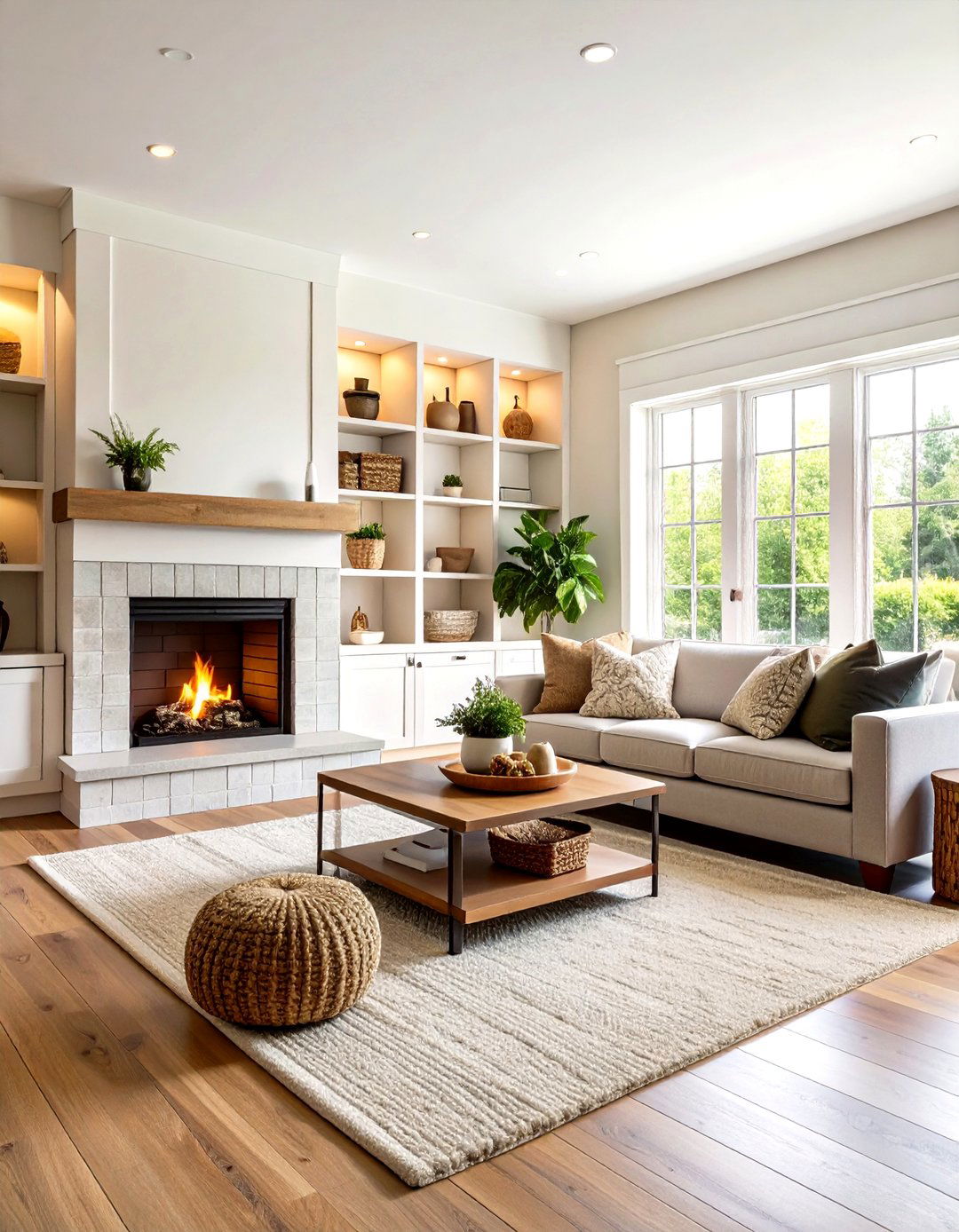
A staggered stack of closed cabinets on one side and airy shelves on the other visually “centers” an off-center fireplace while giving you space for books, baskets, and art. Keep the shelving heights varied so the eye moves up and across, then paint everything — except the firebox — one color for cohesion. Lining the lowest shelf with small baskets hides remotes and matches, and installing puck lights in the upper cubbies adds nighttime drama. The result: big storage, balanced massing, and a fireplace that still reads as the room’s focal point instead of an awkward leftover.
2. Pair a Media Wall Beside the Flames
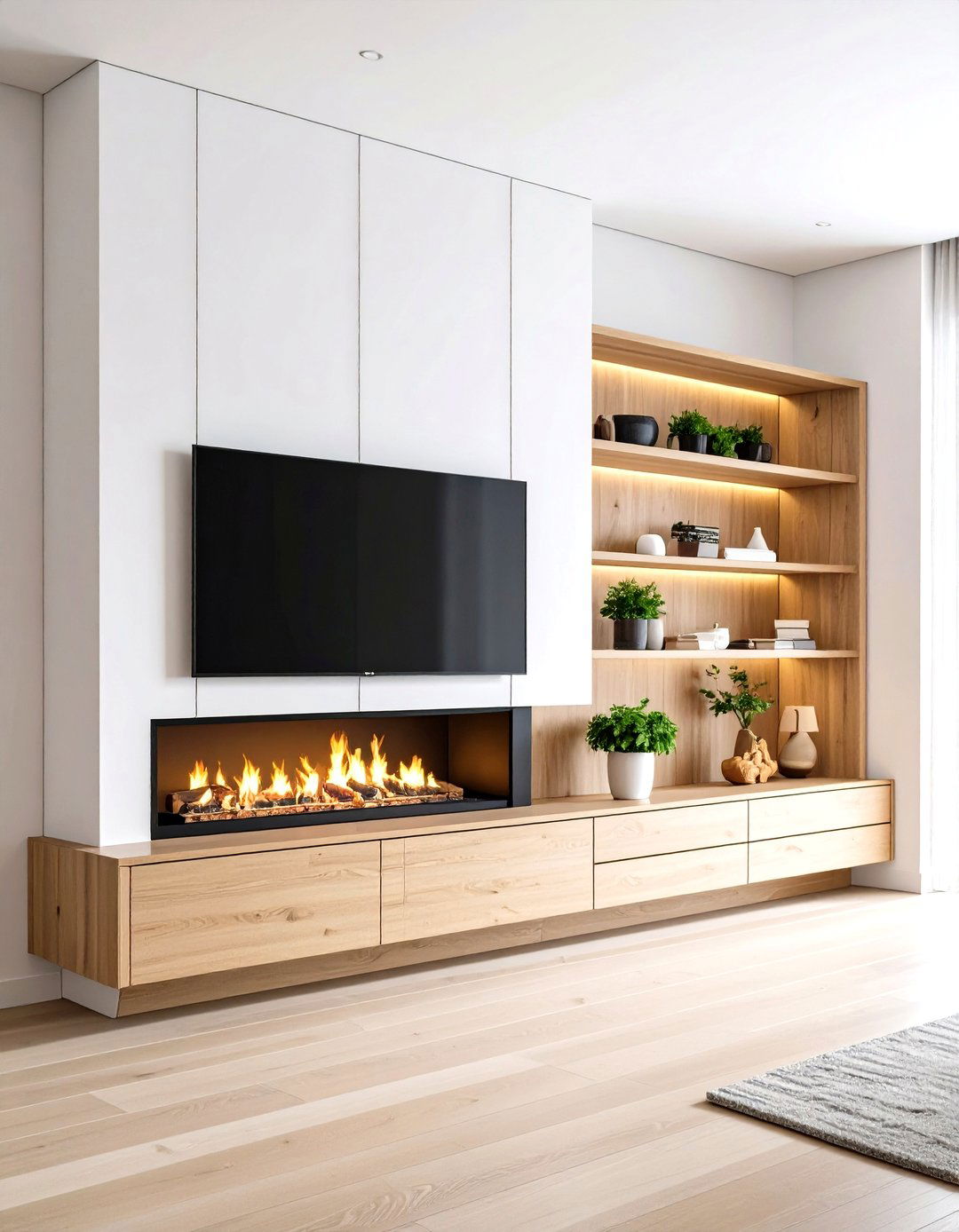
Mounting the TV in its own low console alcove to the wide side of the firebox frees the mantel for art and drops your screen to comfortable eye level. Use the same finish on the console and the fireplace surround — think white oak or limewash plaster — so the two read as one feature. Conceal wires behind a flush panel and run a single floating shelf above the media area to echo the mantel line on the fireplace side. Viewers can watch without neck strain, and the black TV screen no longer competes with flickering flames.
3. Float a Hearth-Bench Below a Shallow Firebox
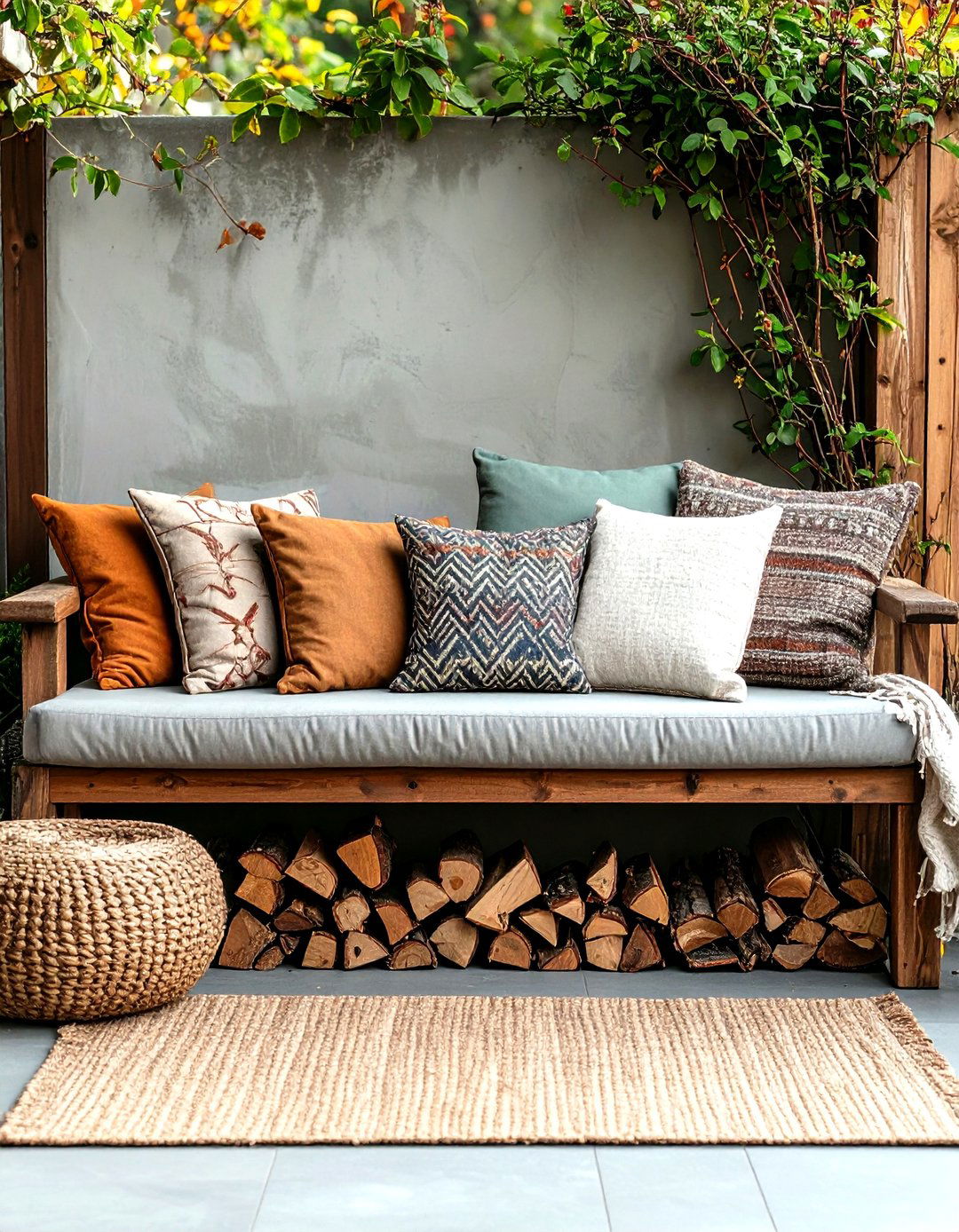
A slim, wall-to-wall bench in matching stone or concrete grounds the fire visually and doubles as overflow seating on game night. Keep the bench no higher than 18 inches so it feels like a built-in ledge rather than furniture. Add two large cushions at the wider end furthest from the firebox; this asymmetrical placement echoes the off-center layout and invites someone to perch while warming their toes. Tuck baskets of kindling under the bench for function, and finish the fascia in the same tone as adjacent flooring so it blends seamlessly.
4. Frame the Off-Center Fire with Corner Windows
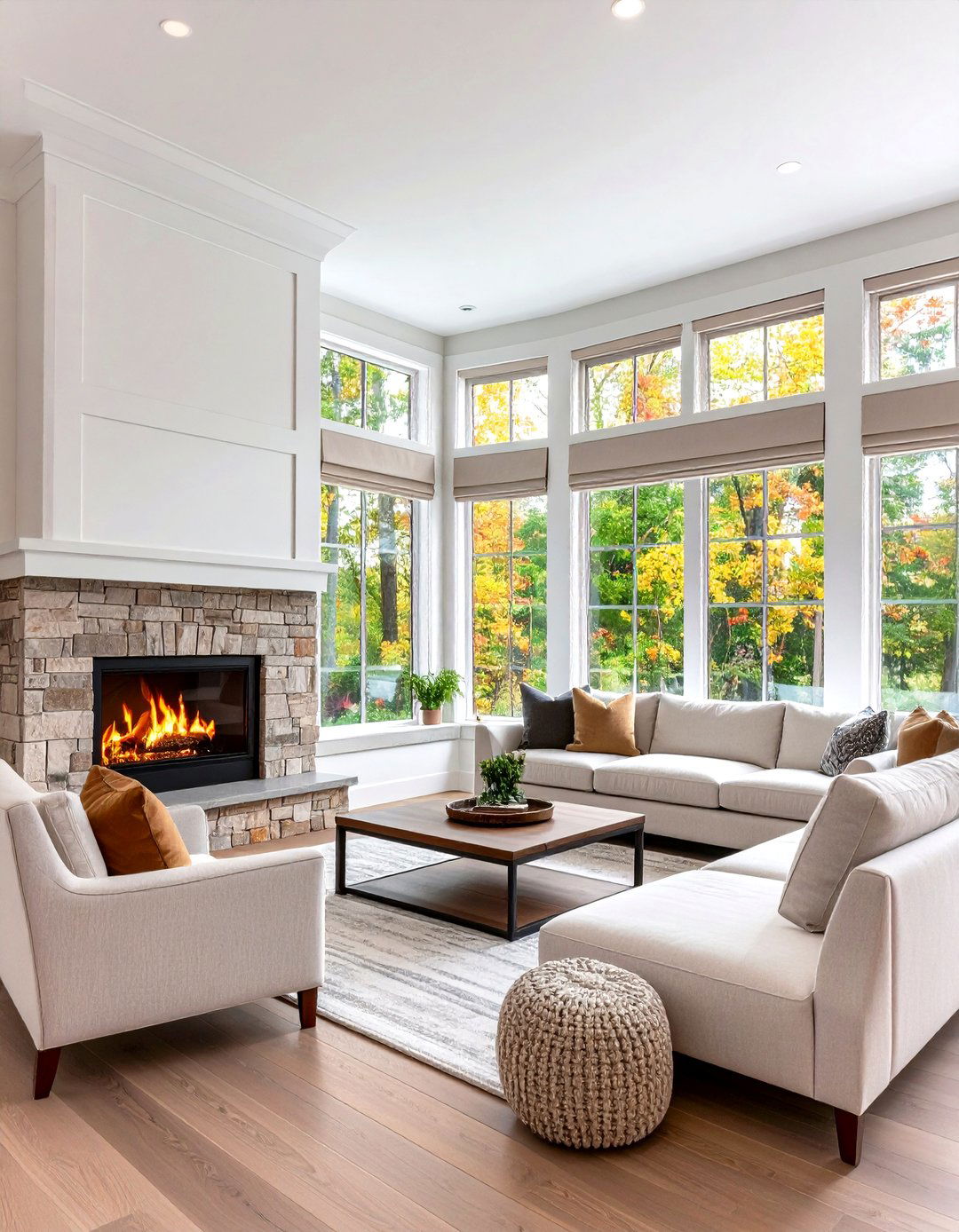
When a fireplace skews left or right, install or highlight windows on the opposite corner to create intentional asymmetry and borrow outdoor views for balance. Floor-to-ceiling glass on one side brings in daylight that counter-weights the dark firebox, while a built-in window seat ties the two focal points together. Choose Roman shades in a tone pulled from the hearth stone to knit the elements, and angle a reading chair toward both flames and landscape for a cozy retreat that celebrates, rather than hides, the fireplace’s drift.
5. Build a Floor-to-Ceiling Stone Column
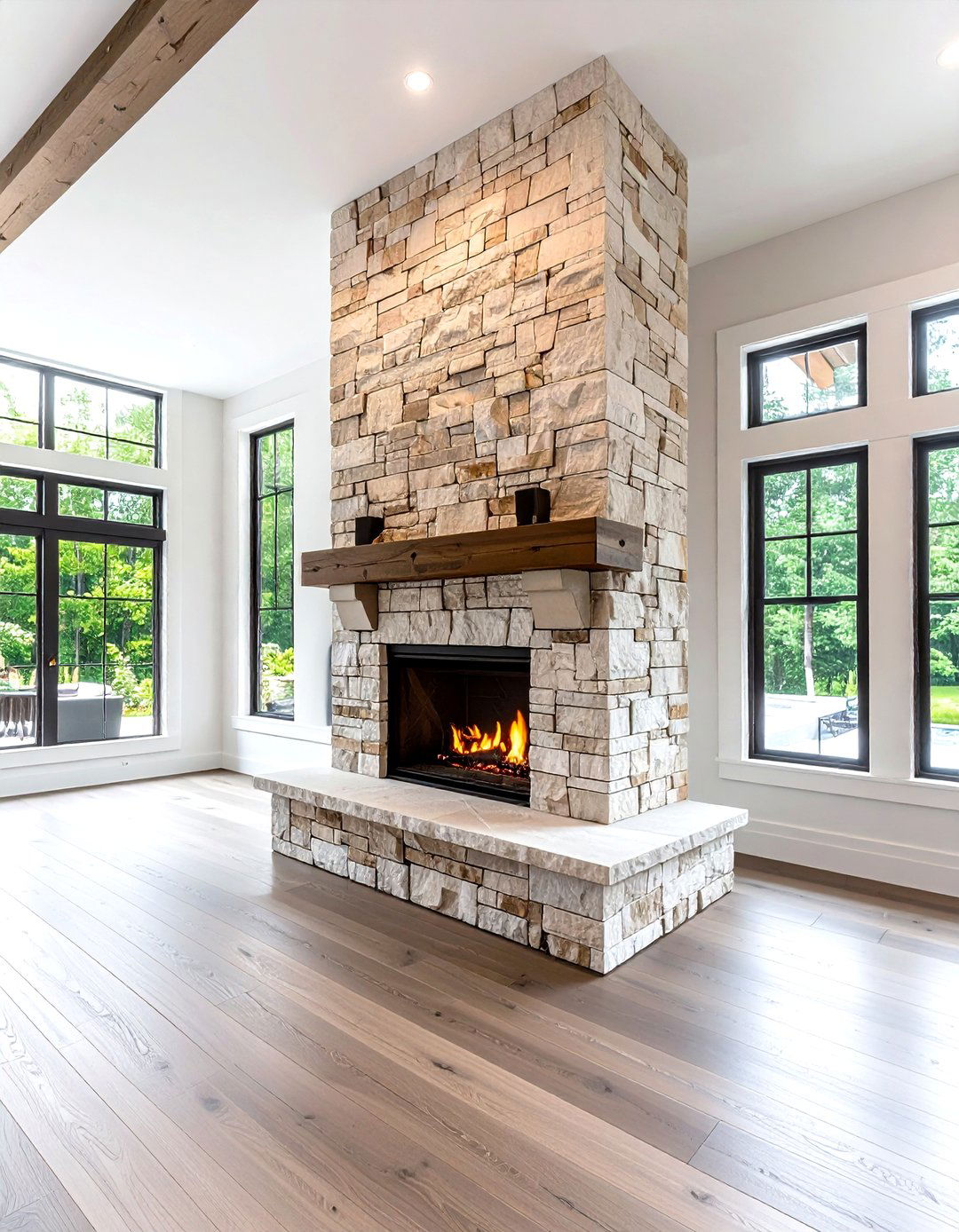
Cladding only the firebox area in a dramatic vertical run of stone — travertine, slate, or stacked river rock — turns the off-center fireplace into an architectural column that feels deliberate. Keep surrounding drywall crisp white so the textural monolith pops. Extend the stone a foot past the mantel on each side, then let it soar to the ceiling without crown molding. This strategy tricks the eye into seeing the column as a structural support rather than an off-placement fluke, while the added height draws attention upward and emphasises room volume.
6. Go Ultra-Modern with a Linear Gas Strip
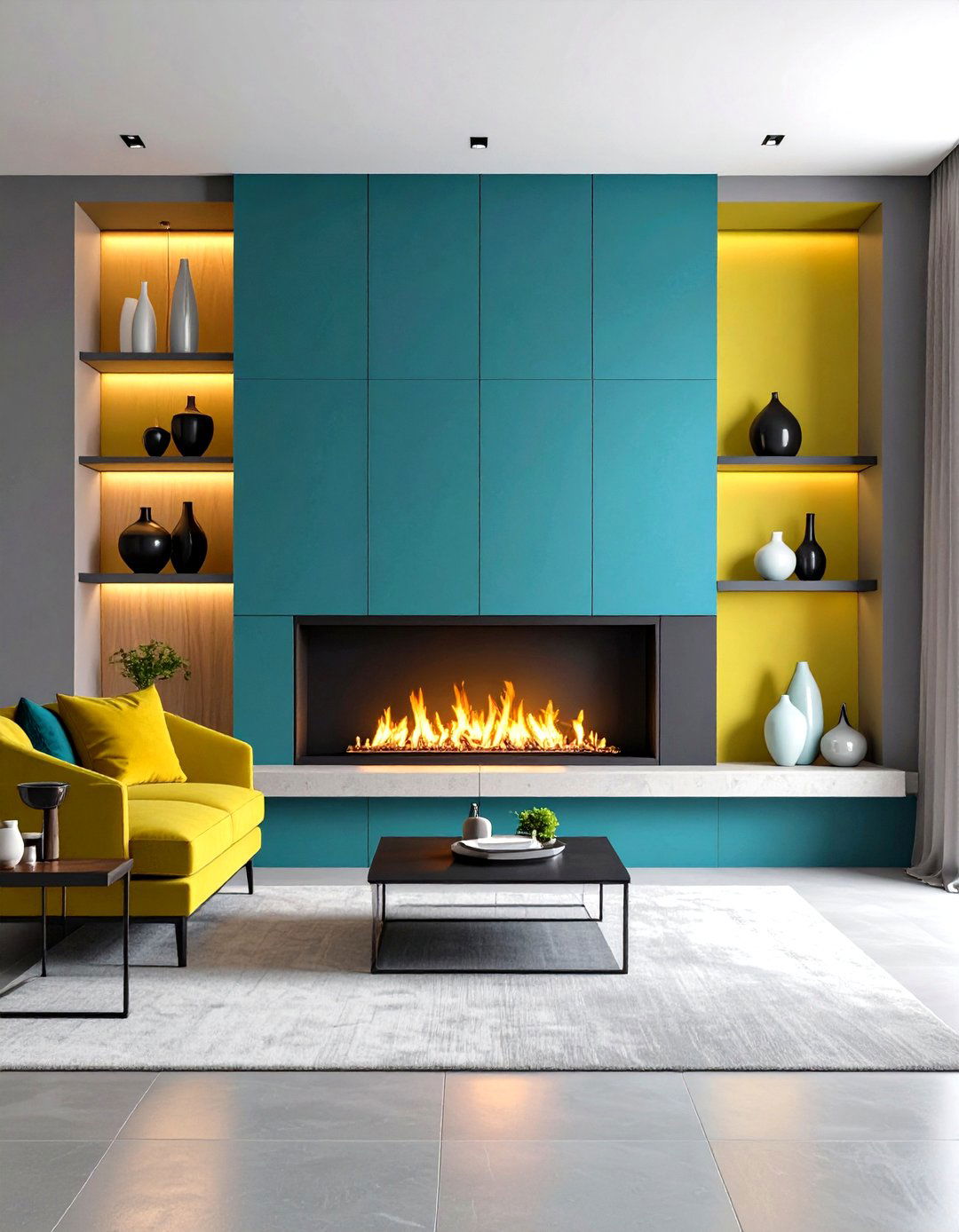
Swap a traditional box for a wide, ribbon-style gas insert set low on the wall; its minimalist profile reads like a long piece of art and spreads heat evenly. Finish the remaining wall in smooth plaster and sit a skinny ledge just above the flame line to display sculptural ceramics. Because the fireband spans most of the wall’s width, its off-center start point feels intentional — more like a design choice than an accident. Pair with low modular seating that echoes the flame’s horizontal sweep for maximum contemporary flair.
7. Create a Double-Sided Room Divider
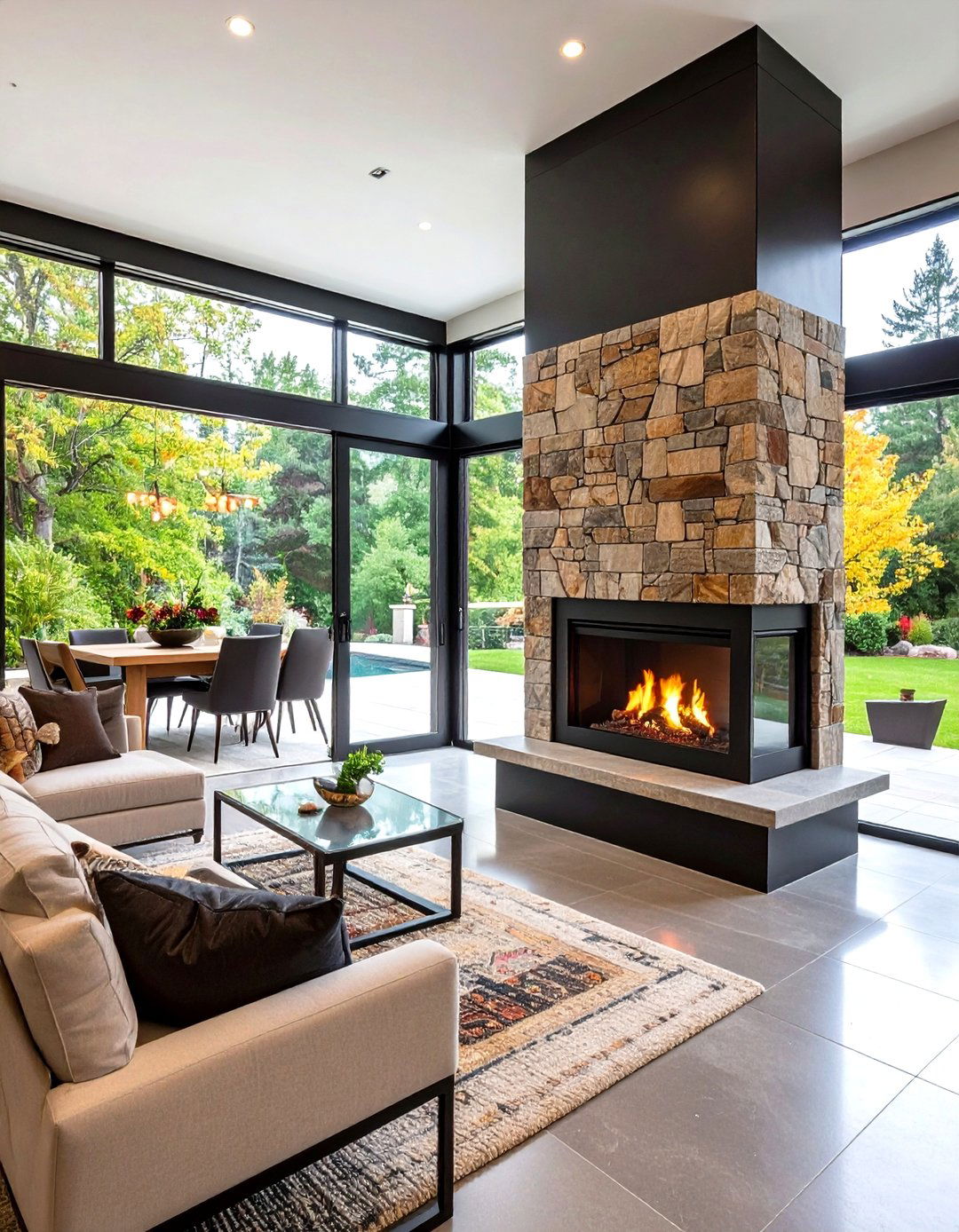
If your fireplace backs up to a hallway or dining area, punch through and install a see-through insert to serve both zones while visually centering the feature within a new partition. Frame the opening in black steel for a slim industrial vibe, and clad only one side in textured tile to preserve subtle asymmetry. The divider now zones open-plan spaces, offers sight-line drama, and lets diners glimpse flickering light without giving up valuable wall length elsewhere. Bonus: vent-free ethanol models make this easier in renovations.
8. Treat the Mantel as a Gallery Rail
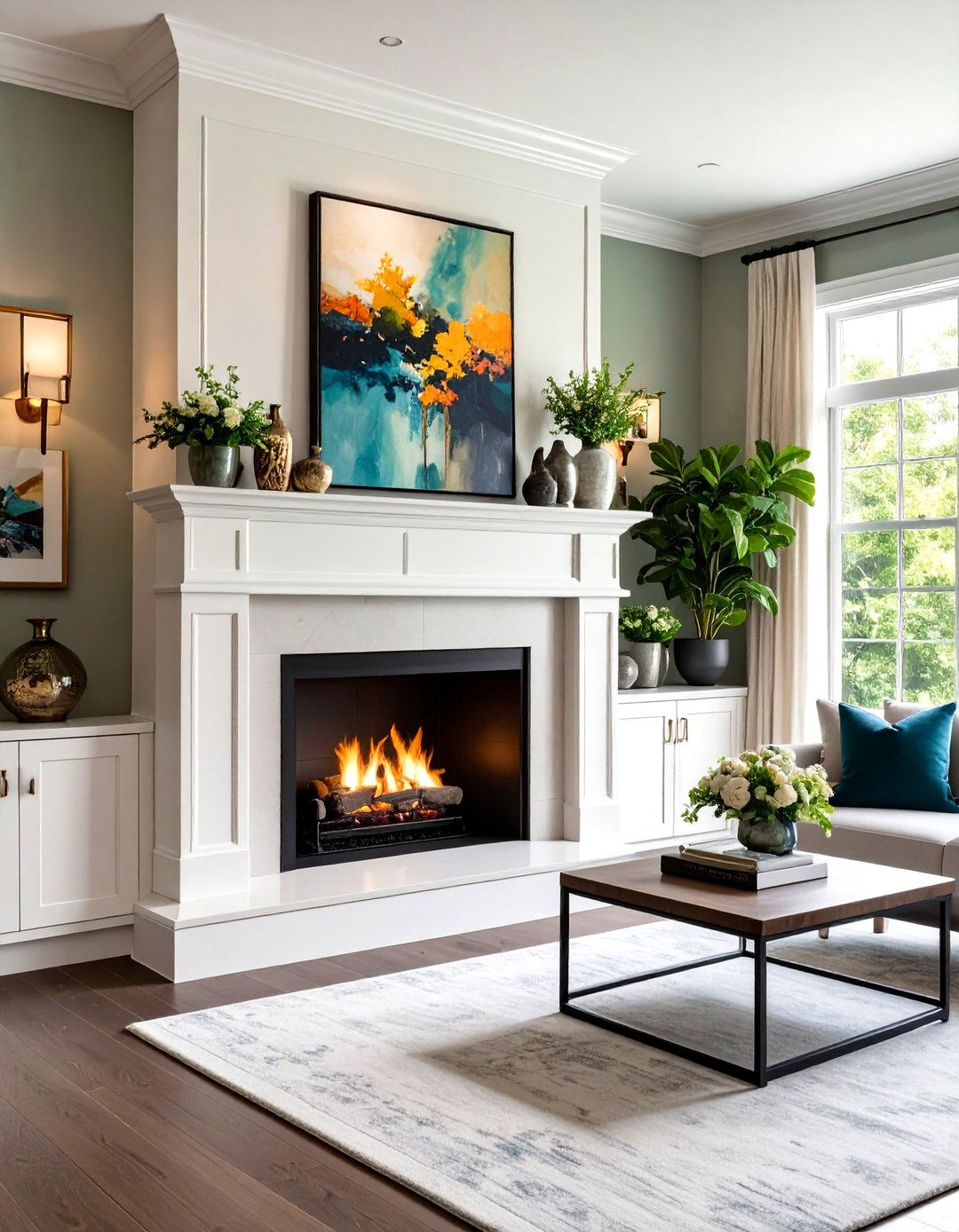
Skip symmetrical sconces; instead, hang an oversized canvas slightly off-axis and layer smaller frames along the mantel, letting art, not the firebox, dictate balance. Choose works that echo your room palette and vary frame depths to build sculptural interest. A slender picture light above the main piece pools glow onto both flame and artwork, tying them together. Rotate prints seasonally so the display feels fresh, proving you can have a visually rich vignette even when the hearth isn’t perfectly centered.
9. Wrap Seating into a Cozy Corner Niche
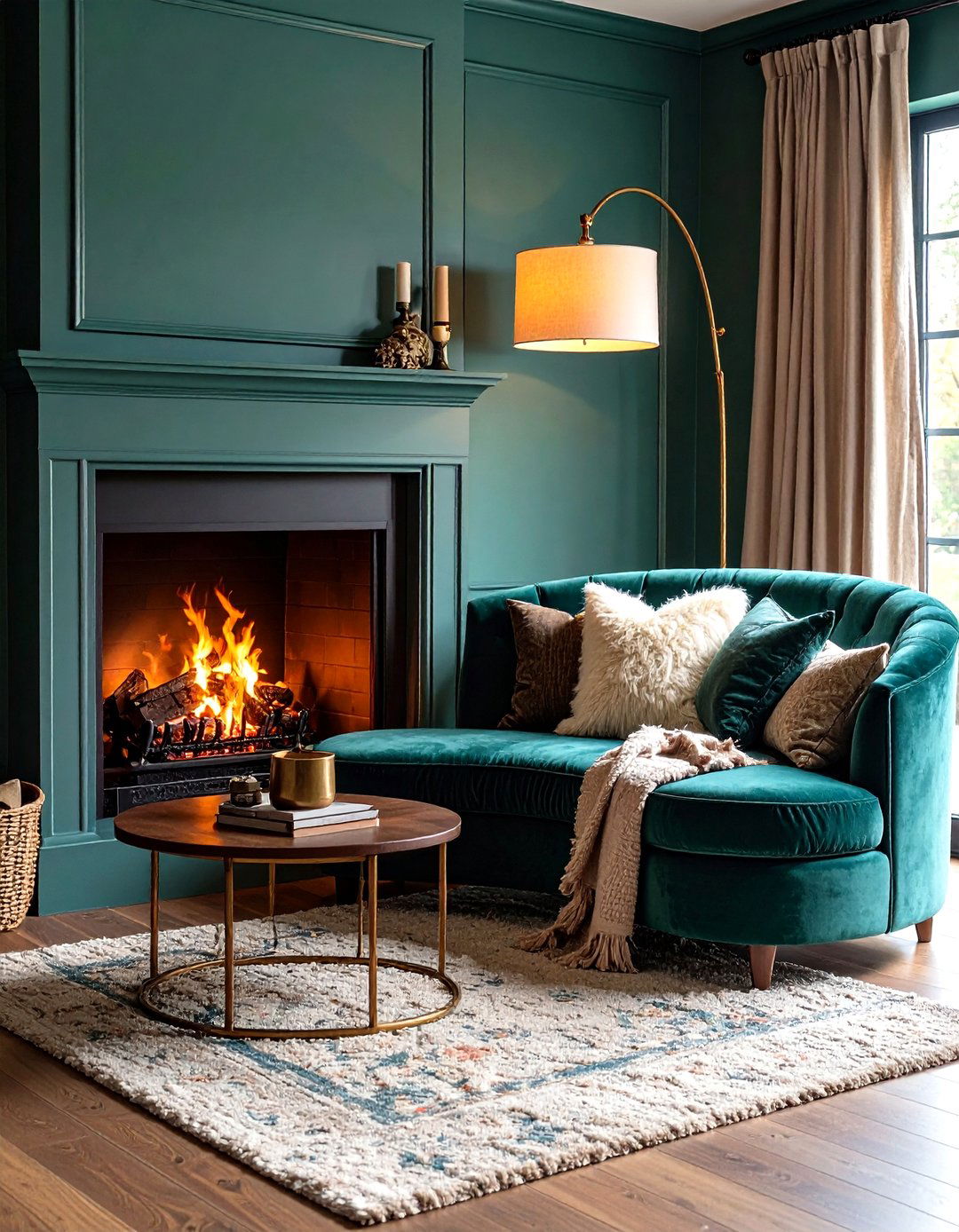
Build a deep, upholstered banquette that hugs the corner closest to the fireplace; its curved backrest guides the eye toward the hearth while providing tucked-away seating for reading or wine chats. Anchor the opposite side with a slim accent table to hold cocoa mugs. Use performance velvet or boucle in a hue pulled from the fireplace surround for continuity, and install a swing-arm reading lamp on the wall above. Now the room has a purposeful nook that transforms an awkward wall break into a destination.
10. Backdrop the Fire with Bold Wallpaper
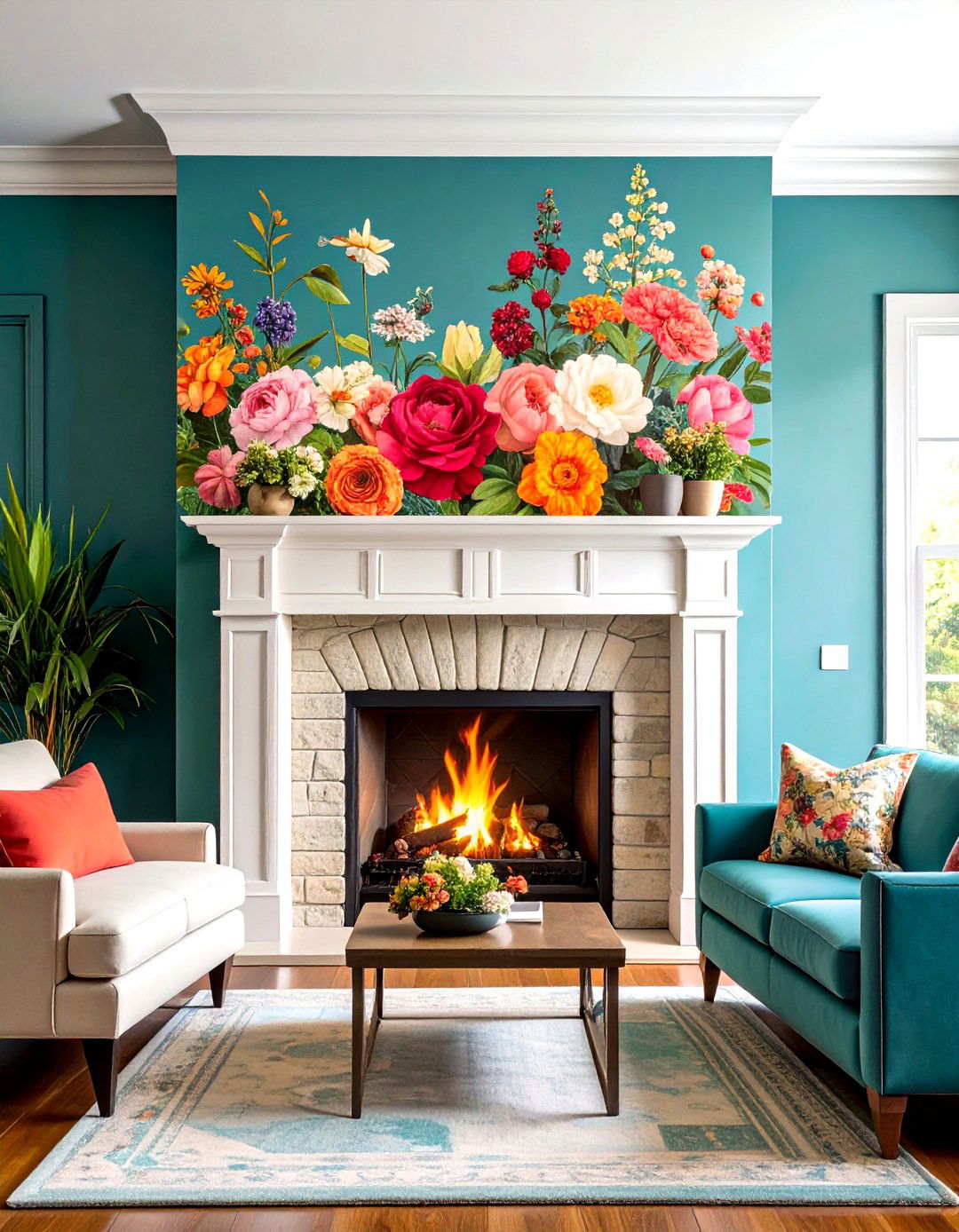
Paper the entire fireplace wall — stone surround and all — in a moisture-safe vinyl mural for instant wow. Look for large-scale botanicals or abstract brushstrokes that stretch across mantel and drywall alike, camouflaging the firebox’s offset location within the pattern. Keep adjacent walls neutral so the print remains a singular statement. For extra depth, add slim picture-frame molding around the wallpapered panel before hanging the paper. The surround now feels artistic and immersive, not misaligned.
11. Mix Materials for Textural Drama
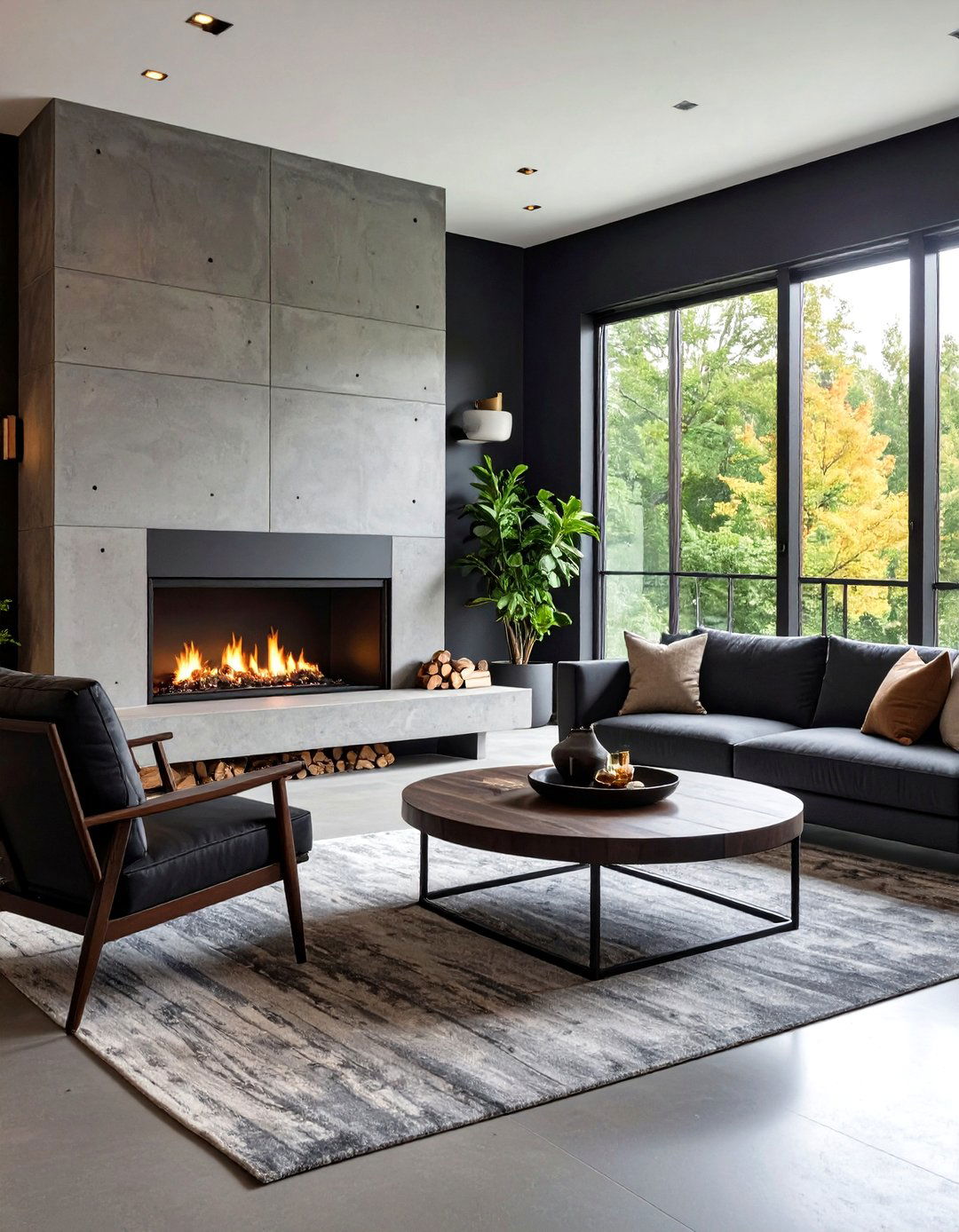
Combine two surface treatments — say, charred-wood planks on the lower half and smooth microcement above — to celebrate the fireplace’s off-center quirk rather than hide it. Run the material change at mantel height to create a strong horizontal line, then echo the darker tone elsewhere with a coffee table or beam. The juxtaposition brings depth and highlights craftsmanship, while subtle repetition of color throughout the room threads everything together.
12. Add a Vertical Fluted Panel
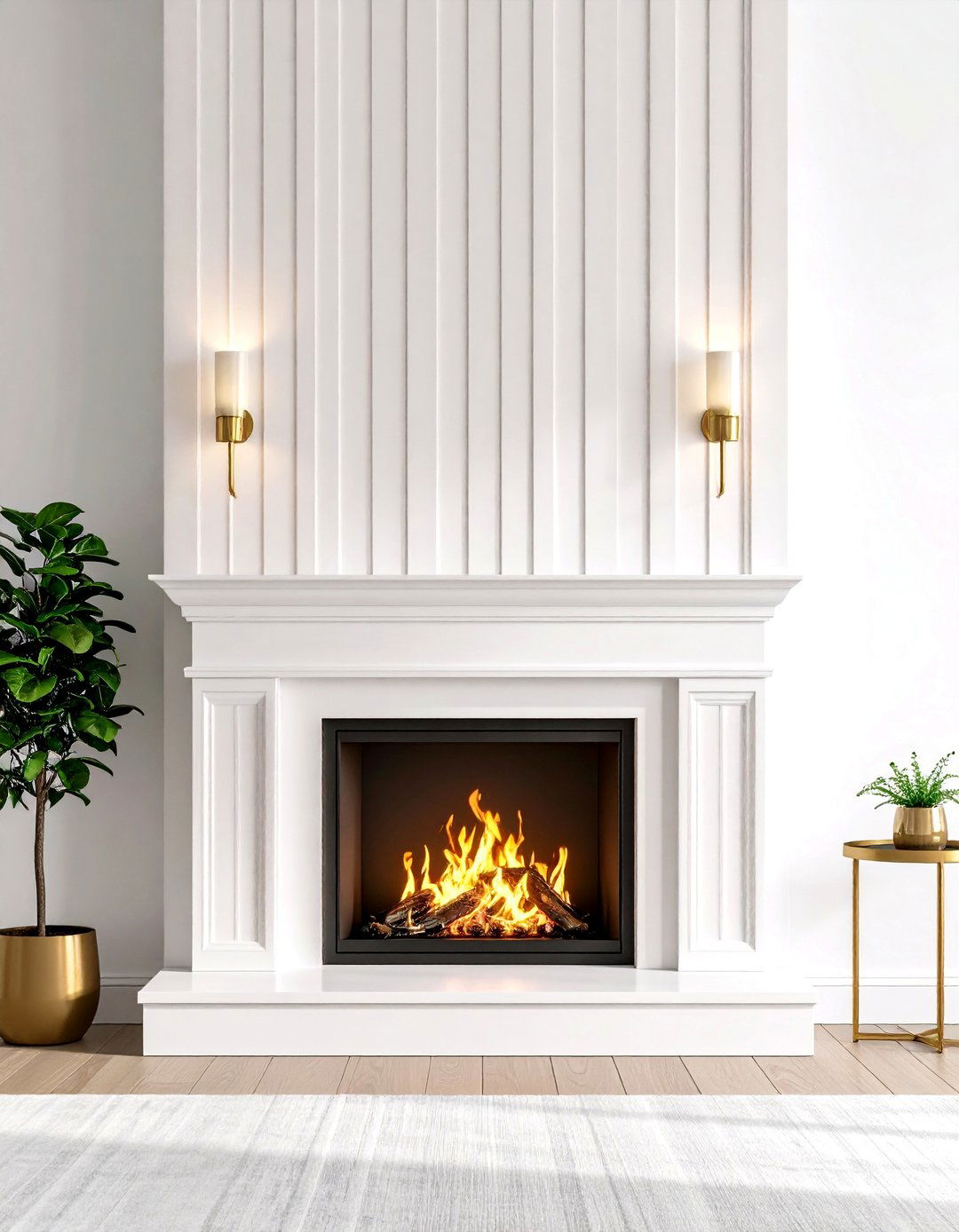
Fluted MDF or plaster boards installed only on the firebox side give rhythmic shadow lines that draw attention without requiring symmetrical repeats. Paint the panel and mantel the same tone — rich ecru or moody charcoal — so grooves stand out. Leave the opposite wall flat, and hang a slim brass sconce there for sparkle. The tactile finish makes the fireplace look purpose-built, and the single-sided application keeps the overall wall from feeling heavy.
13. Extend Height with Reclaimed Wood
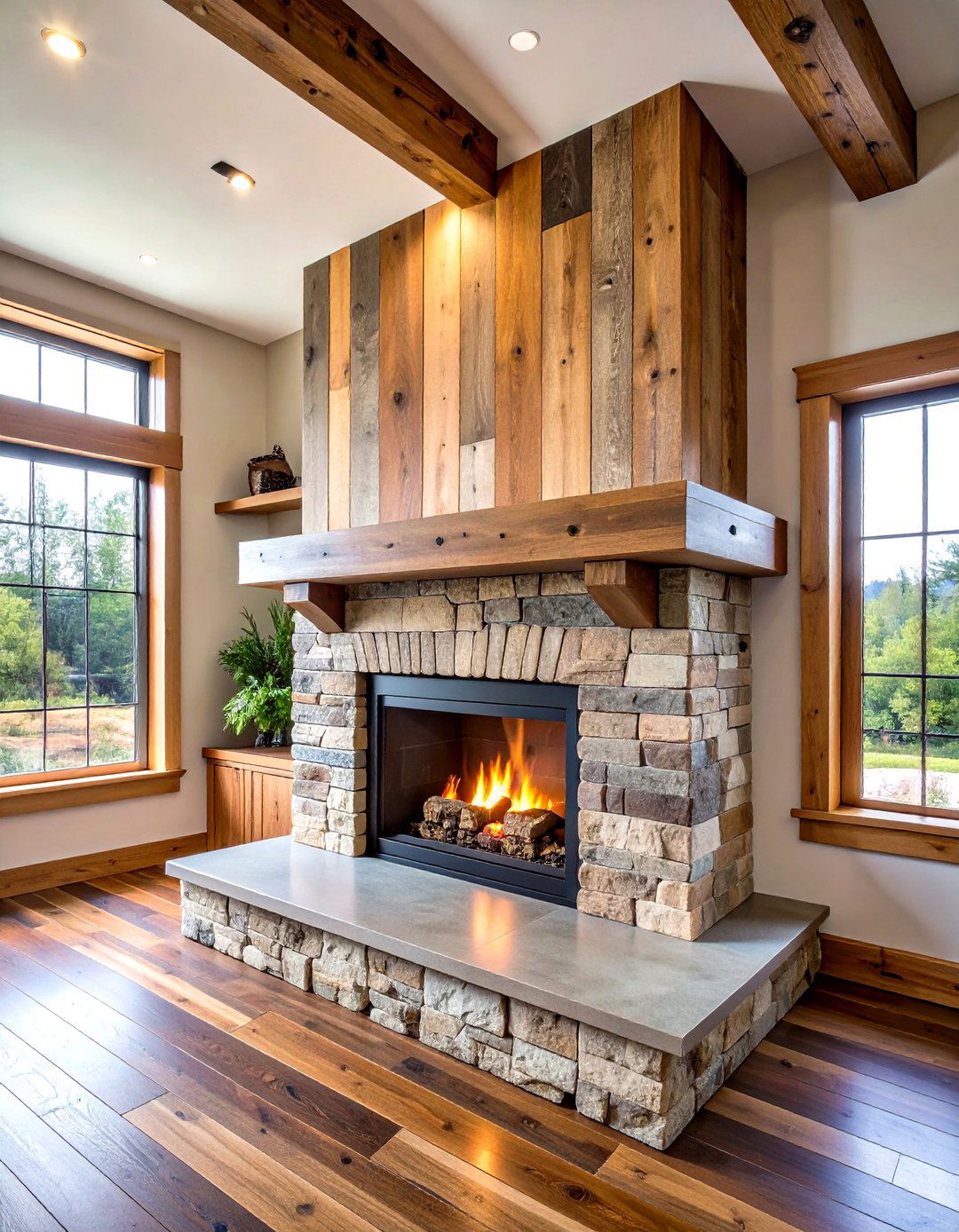
Clad the chimney breast in vertical reclaimed boards that rise to the ceiling, then float a mantel in matching timber so grain flows uninterrupted. Stagger board widths for a rustic-modern vibe, sealing with matte polyurethane to preserve patina. The wood’s organic lines distract from the offset location, and its warmth pairs beautifully with clean-lined furniture elsewhere. Tuck slim LED uplights behind the mantel to wash light up the planks, emphasizing height even further.
14. Sculpt a Curved, Fluted-Plaster Surround
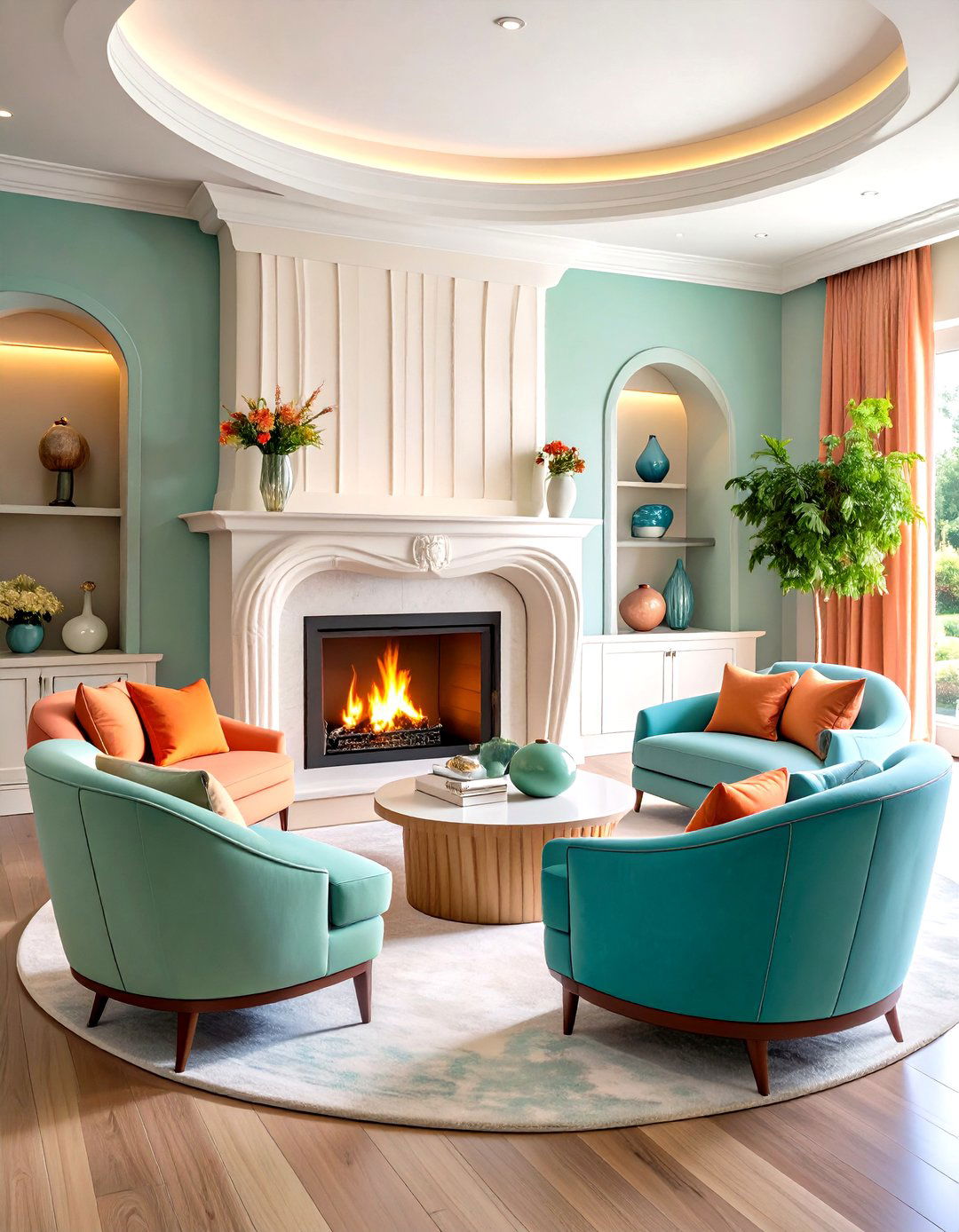
A gentle radius applied in plaster softens the fireplace edges and makes an off-center layout feel like intentional modern sculpture. Combine with fluting for subtle shadow play. Because curves naturally lead the eye, viewers focus on form rather than position. Keep finishes tone-on-tone — think warm white plaster against creamy walls — and style with rounded furniture pieces that echo the arc, reinforcing cohesion.
15. Carve Discreet Storage Niches
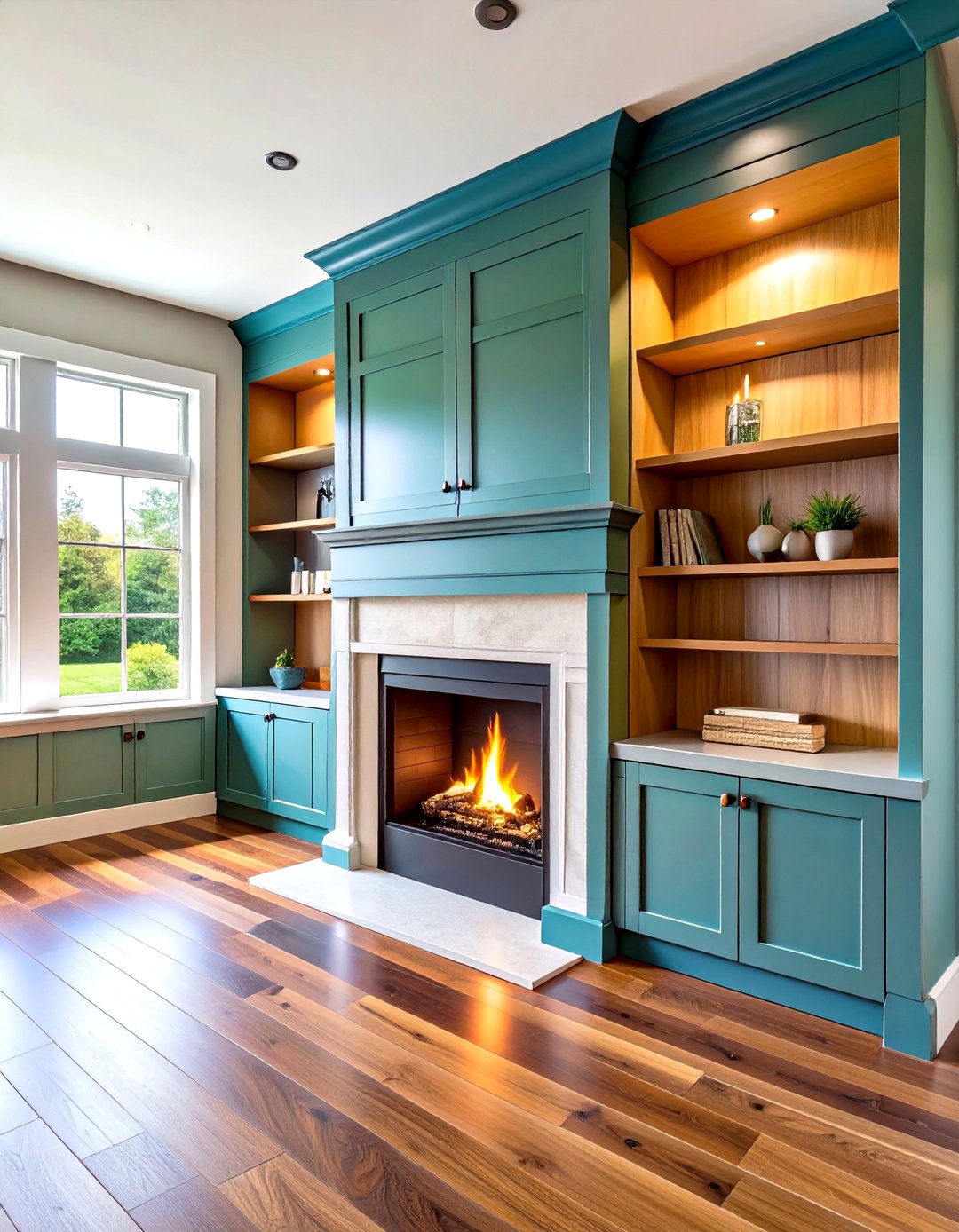
Shallow, door-front cabinets hidden behind flush paneling on the wider side of the firebox swallow remotes, matches, and board games without breaking sightlines. Use push-latch hardware so no handles distract. Paint niches and wall the same color, but line interiors with a contrasting veneer for a secret jewel-box feel. When closed, storage disappears; when open, it proves every inch serves purpose despite asymmetry.
16. Slide in a Compact Home Bar

Transform the broader side of the off-center wall into a mini bar complete with wine fridge, narrow countertop, and open glass racks ࣄciteࣂturn1news30ࣂturn2search3ࣁ. Mirror the back panel to reflect flickering flames and add depth. A pocket bar door can slide shut when not in use, keeping the focus on the hearth. Evening cocktails by the fire now feel hotel-luxurious — and you’ve maximized an otherwise dead sliver of wall.
17. Build a Verdant Plant Ledge
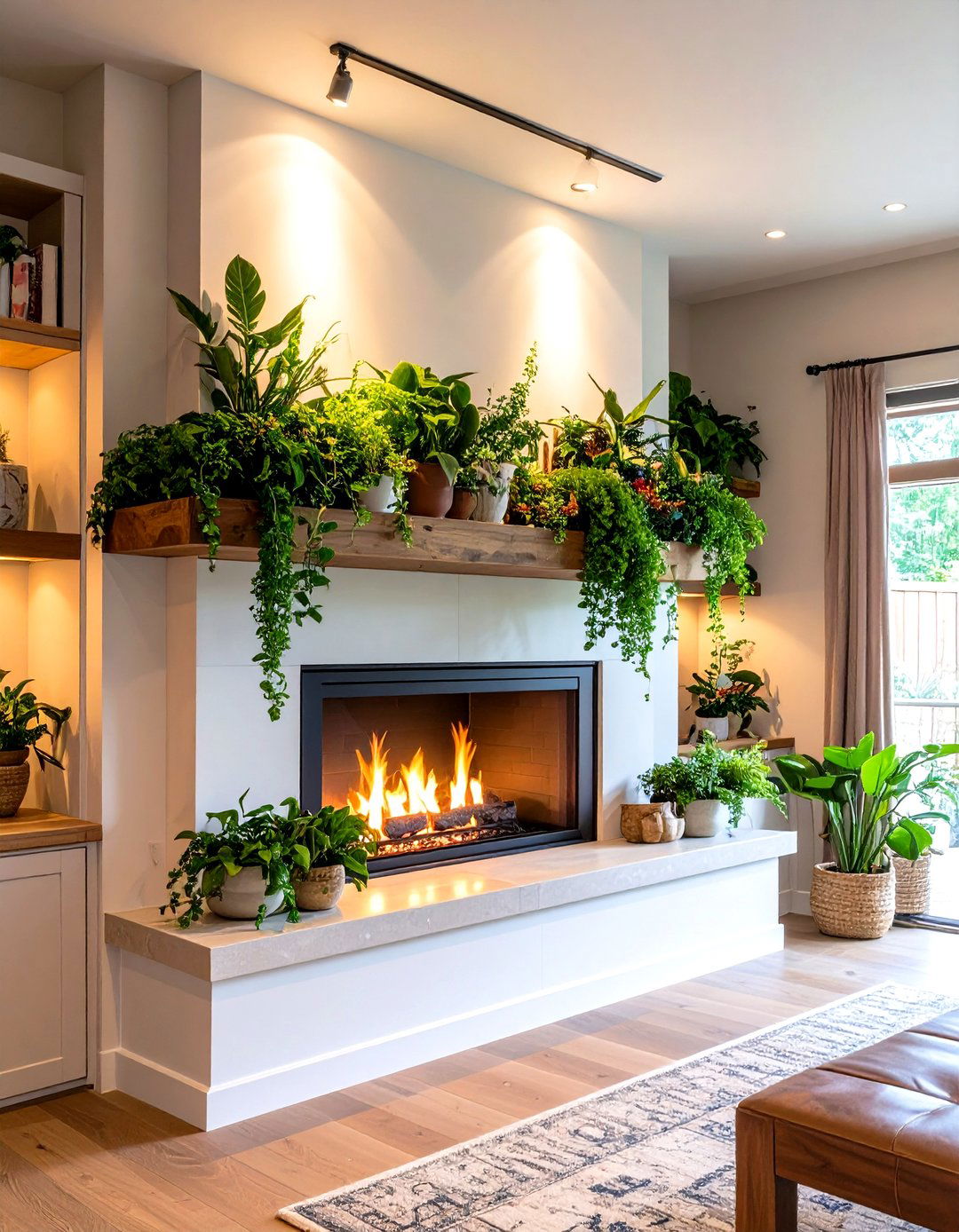
Install a floating ledge above the firebox and cascade trailing pothos, philodendron, or faux greenery for low-maintenance flair. Taller floor plants balance the opposite side, bringing symmetry through foliage rather than architecture. Choose terracotta or matte ceramic pots to echo hearth materials, and spotlight the greenery with a track light that also grazes the stone. The living elements soften hard lines and shift focus from placement to lush texture.
18. Feature a Sculptural Metal Hood
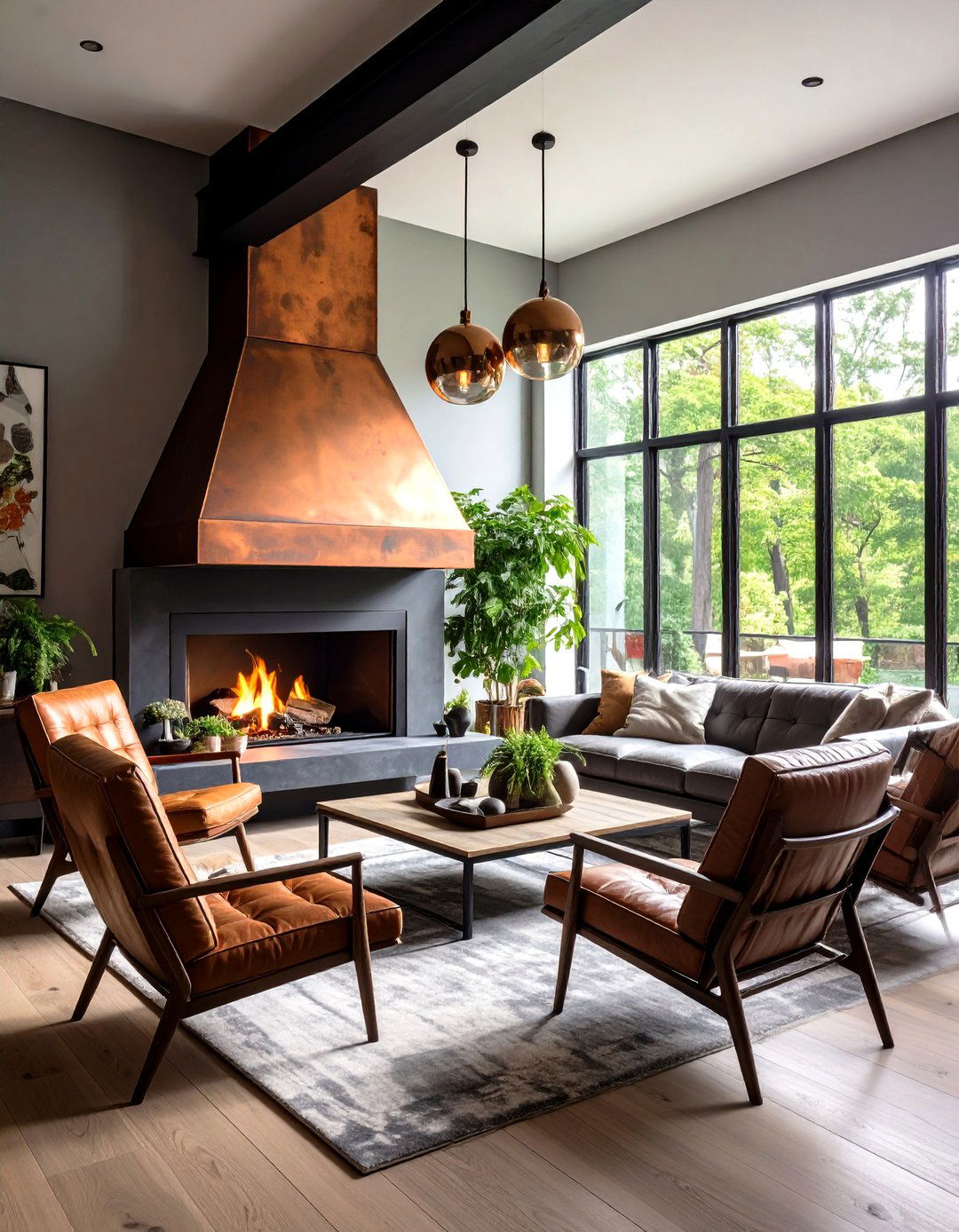
A custom, asymmetrical metal hood — think patinated copper or blackened steel — adds drama and channels historic European inglenook vibes. Let it slope wider on the side opposite the firebox, echoing the offset while disguising it. Pair with minimal art so the hood stands unchallenged, and anchor the look with leather sling chairs for an industrial-meets-organic mood.
19. Lower the Fire Into a Long Bench
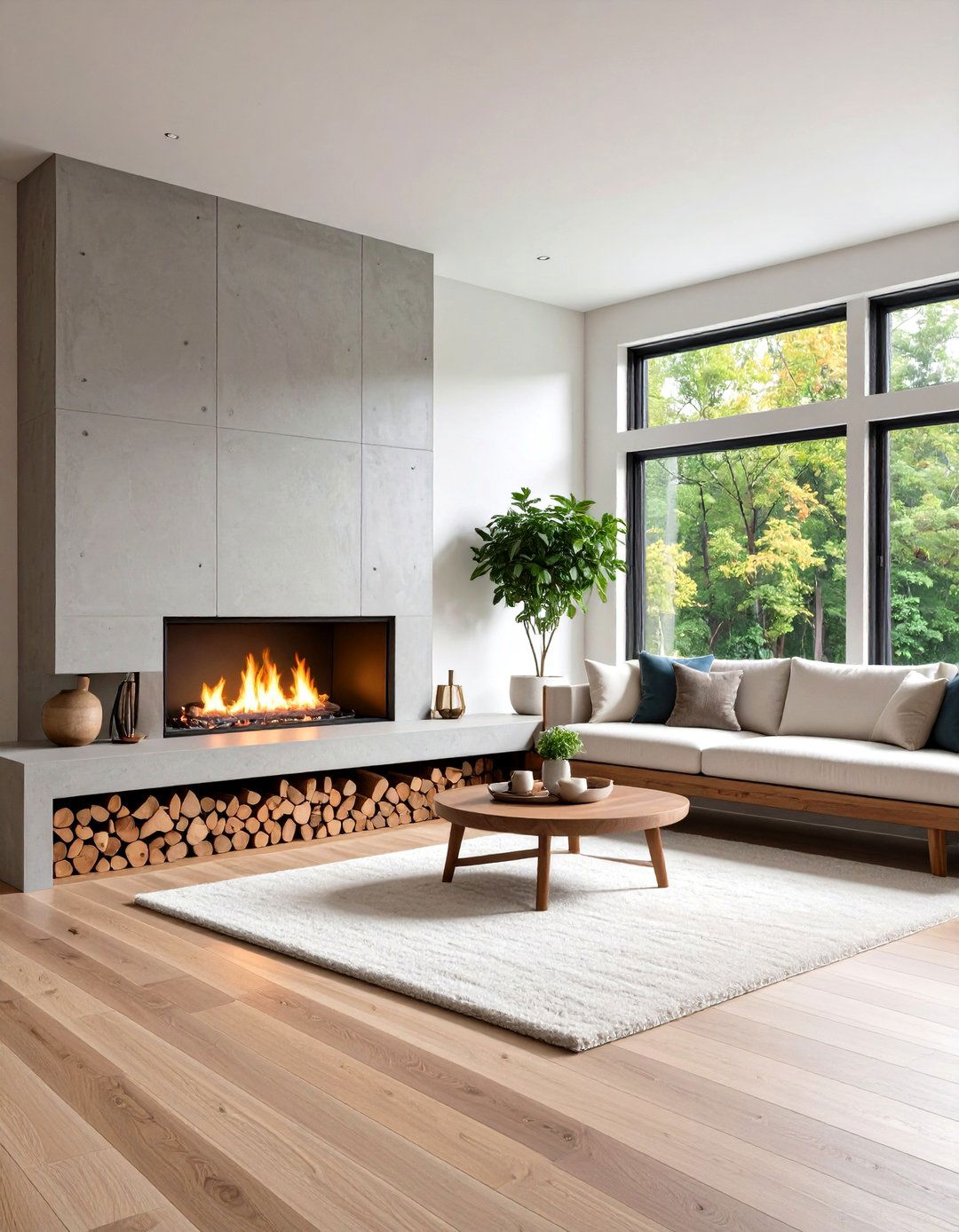
A stretched, low insert installed just eight inches above finished floor — paired with a continuous concrete bench — invites lounging and visually lowers the room’s center of gravity. Because the bench runs wall-to-wall, the fire’s start position feels like a deliberate punctuation rather than misalignment. Add a slim seat pad on the wider end to turn it into a daybed, and store wood below in a recessed cubby for utilitarian charm.
20. Layer Mirrors and Art for Depth
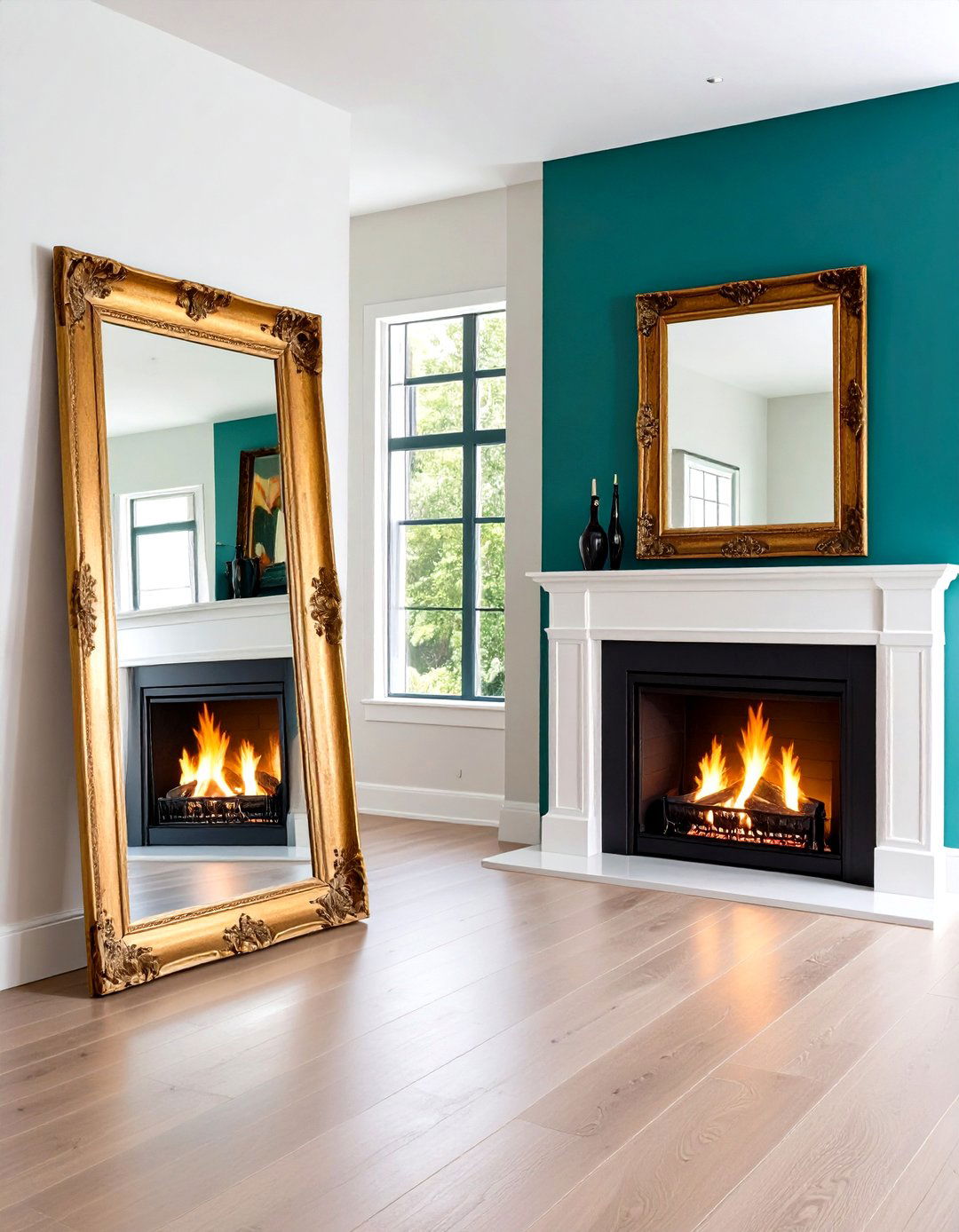
Mount an oversized antiqued mirror on the narrow side of the wall and lean a framed print against it to reflect flames and bounce light. Mirrors visually double the fire, making the offset disappear, while staggered art layers create rich dimension. Choose frames in the same metal finish as fireplace tools to pull the vignette together without visual clutter.
21. Install a Smart Electric Ribbon
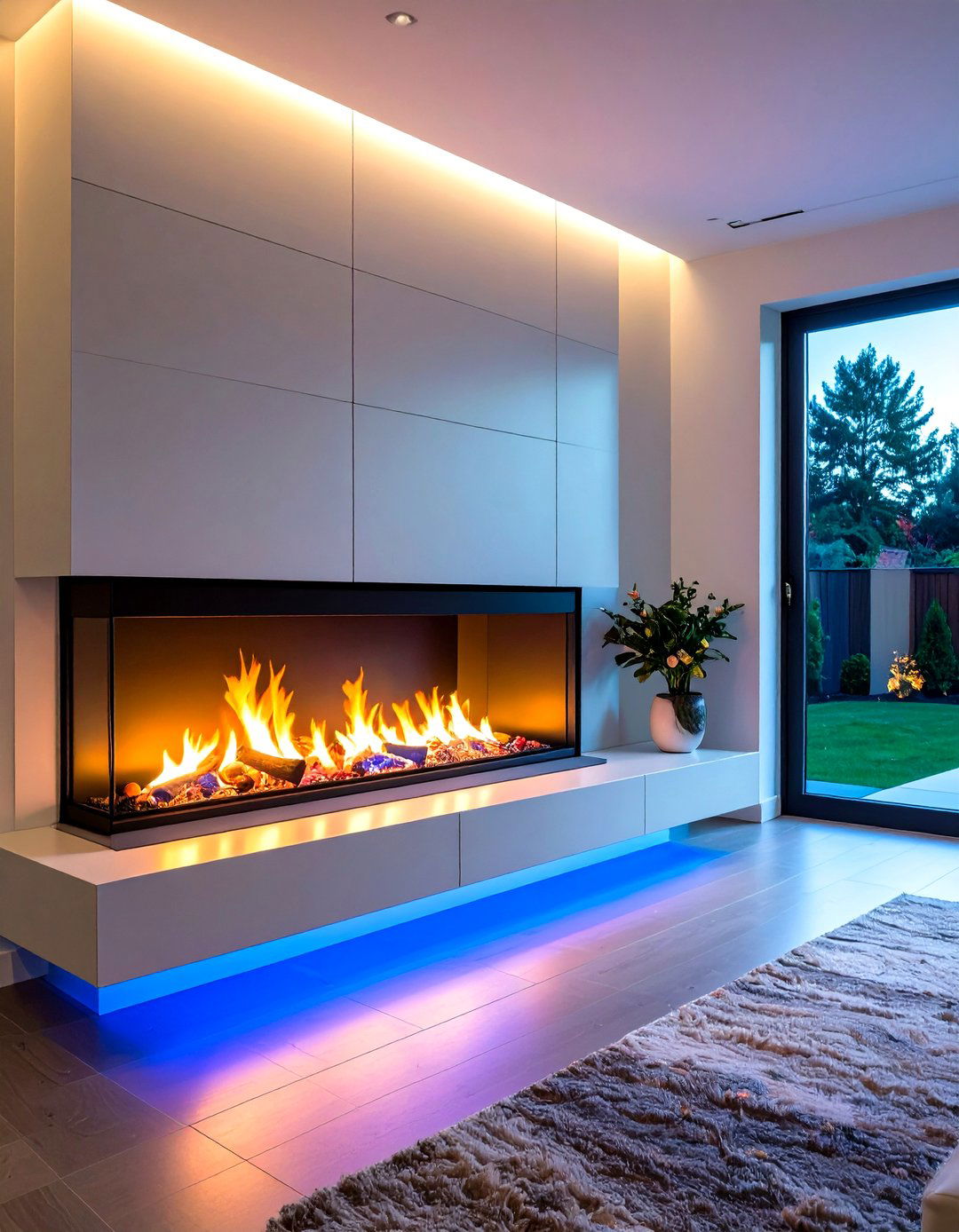
If venting limits placement, a slim electric ribbon fireplace can mount almost anywhere — and even shift color temperature via app control. Its low profile lets you tuck it beneath existing built-ins or a window, embracing the off-center spot while still delivering ambiance. Include Alexa or Google Home integration for voice-controlled flames that sync with lighting scenes for movie night.
22. Float an L-Shaped Sofa Around the Hearth
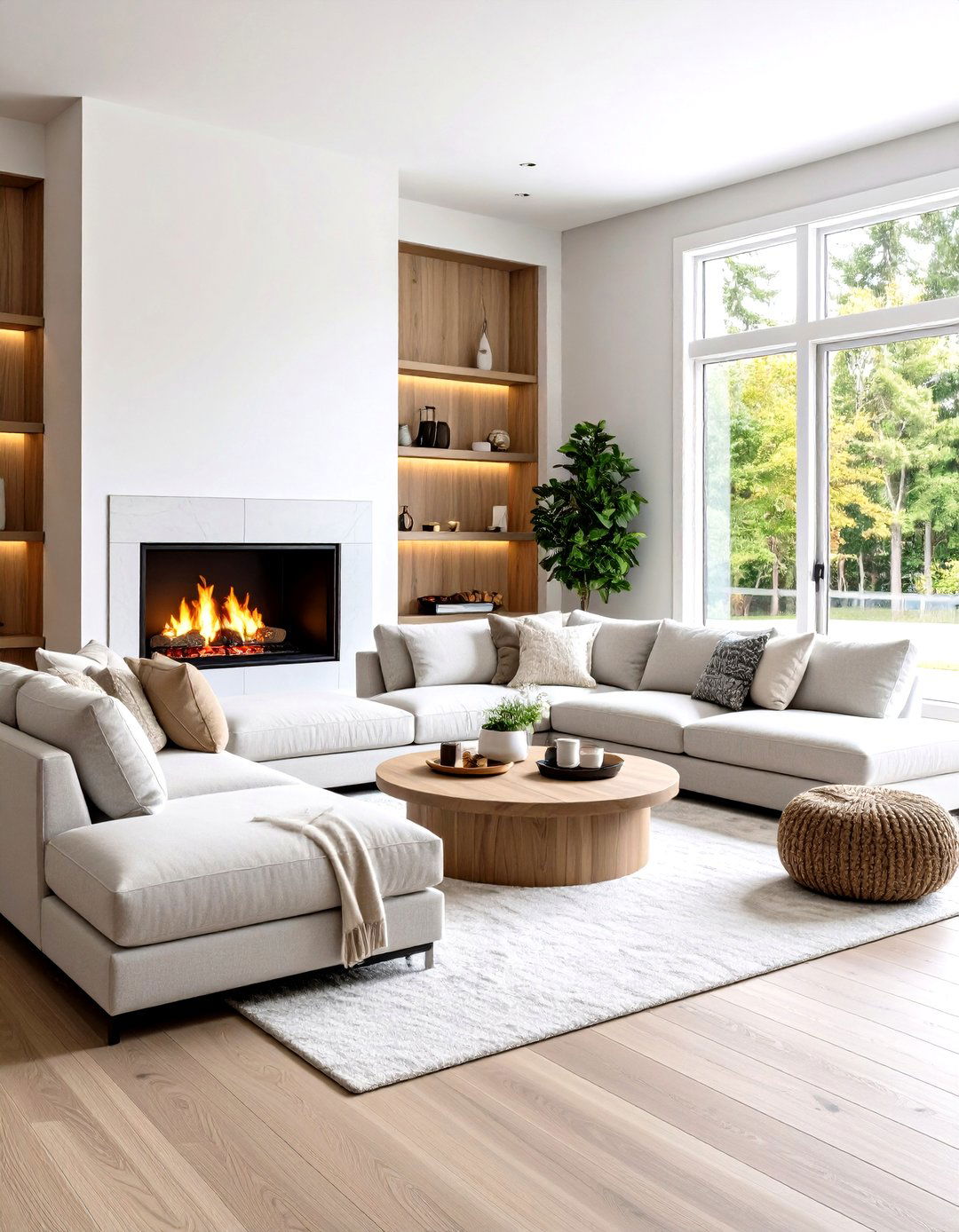
Position the long side of an L-shaped sectional facing the fire and the shorter chaise toward the wider side wall; this layout wraps occupants in warmth and visually hugs the asymmetrical wall. Place a round coffee table in the elbow of the “L” so traffic flows easily behind the sofa. The curved seating line offers balance where architecture doesn’t.
23. Use a Pivoting Swivel-Arm TV
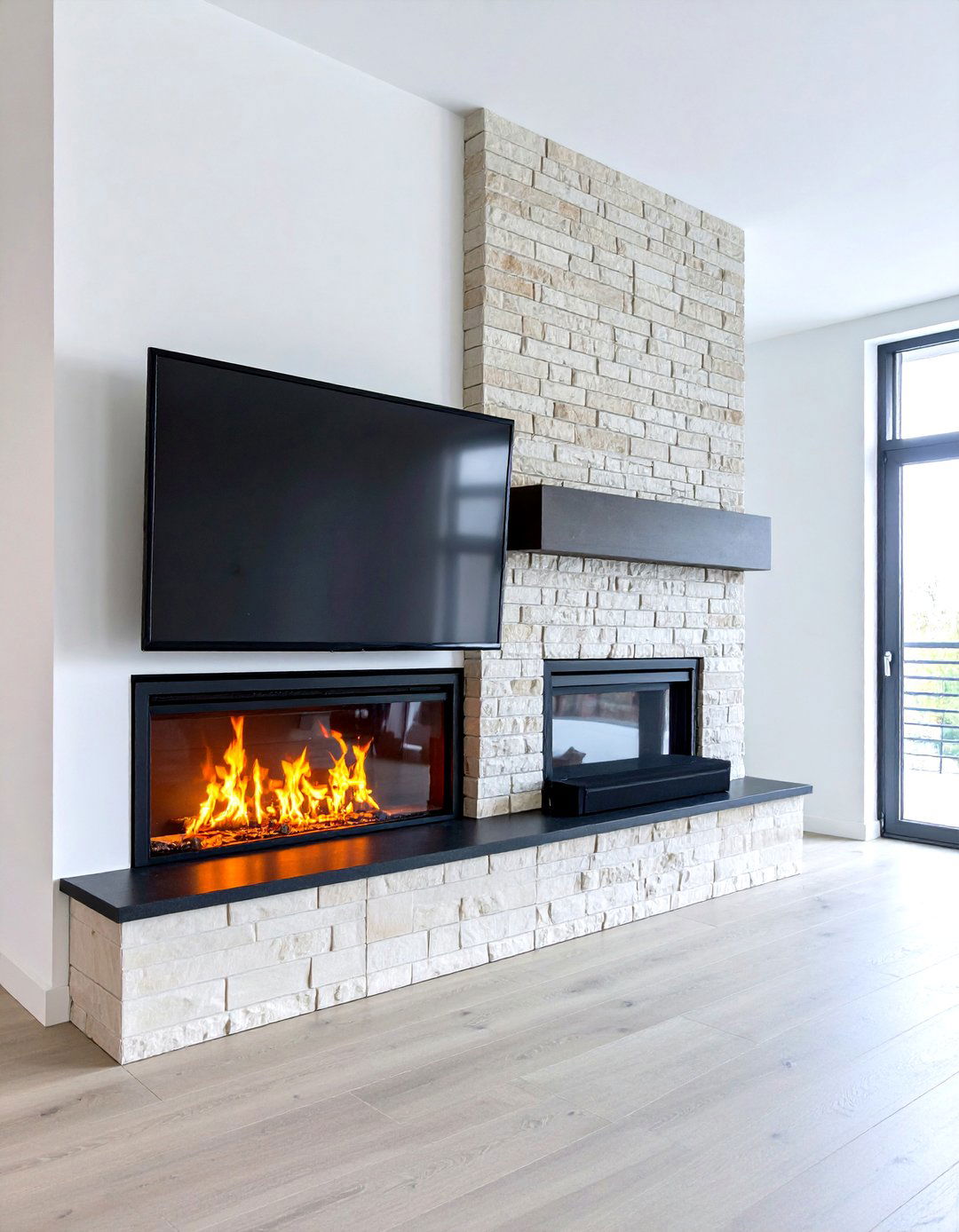
Mount your screen on a full-motion arm beside — not above — the fireplace, allowing you to angle it toward seating when needed and tuck it flatter when flames should shine. Paint the mounting wall a darker hue to downplay the TV’s presence, and stash a slim soundbar under the mantel for stealth audio. Function meets aesthetics without diminishing the hearth’s status.
24. Rim the Surround with LED Glow
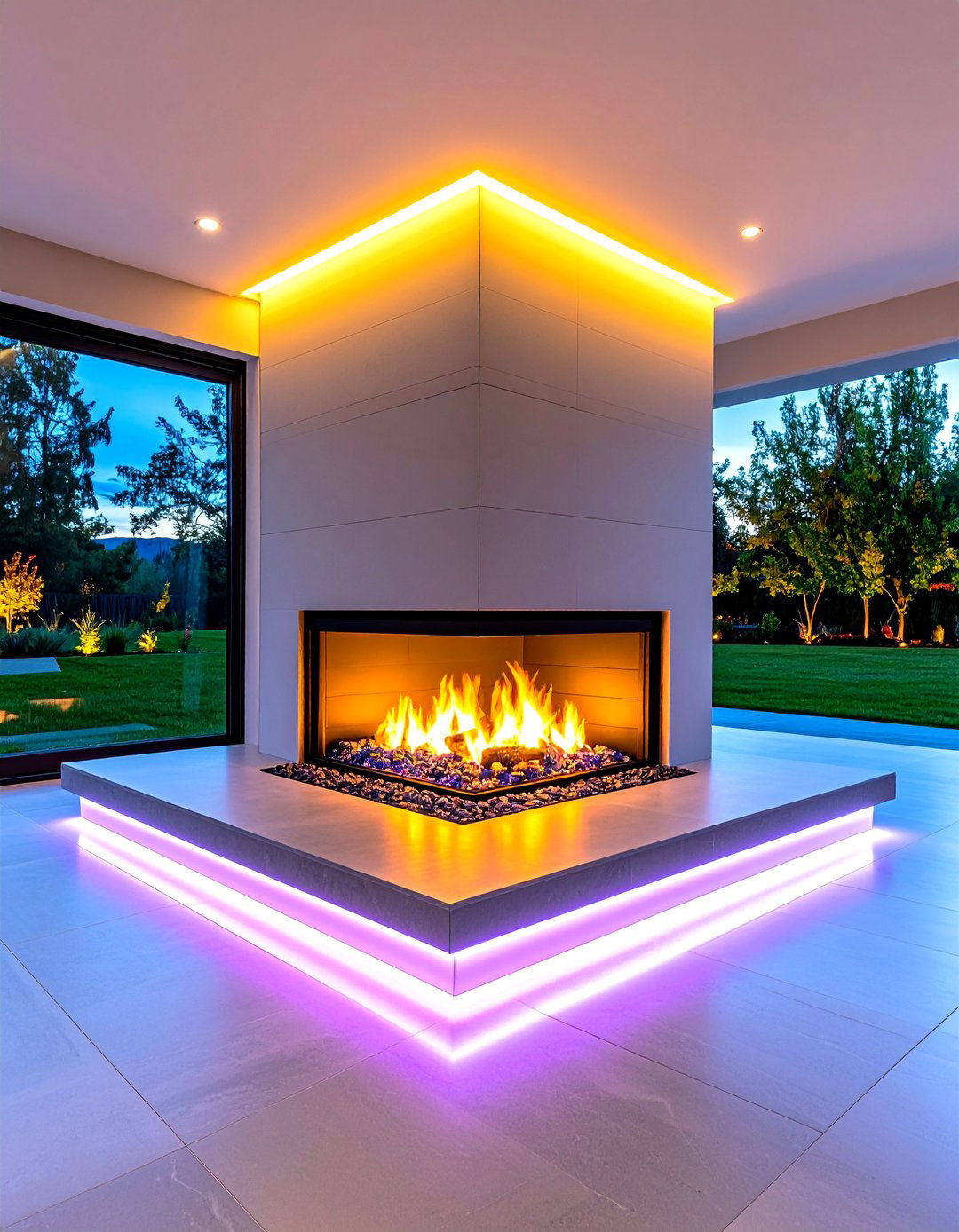
Discreet, color-tunable LED strips recessed into a ¾-inch reveal around the fireplace cast a gentle halo that accentuates shape after dusk. Opt for warm 2700-K light to echo flame or shift to muted amber for movie time. Because the light source is hidden, the fireplace appears to float, and the subtle glow distracts from off-center positioning.
25. Design a Seasonal Swap-Out Station
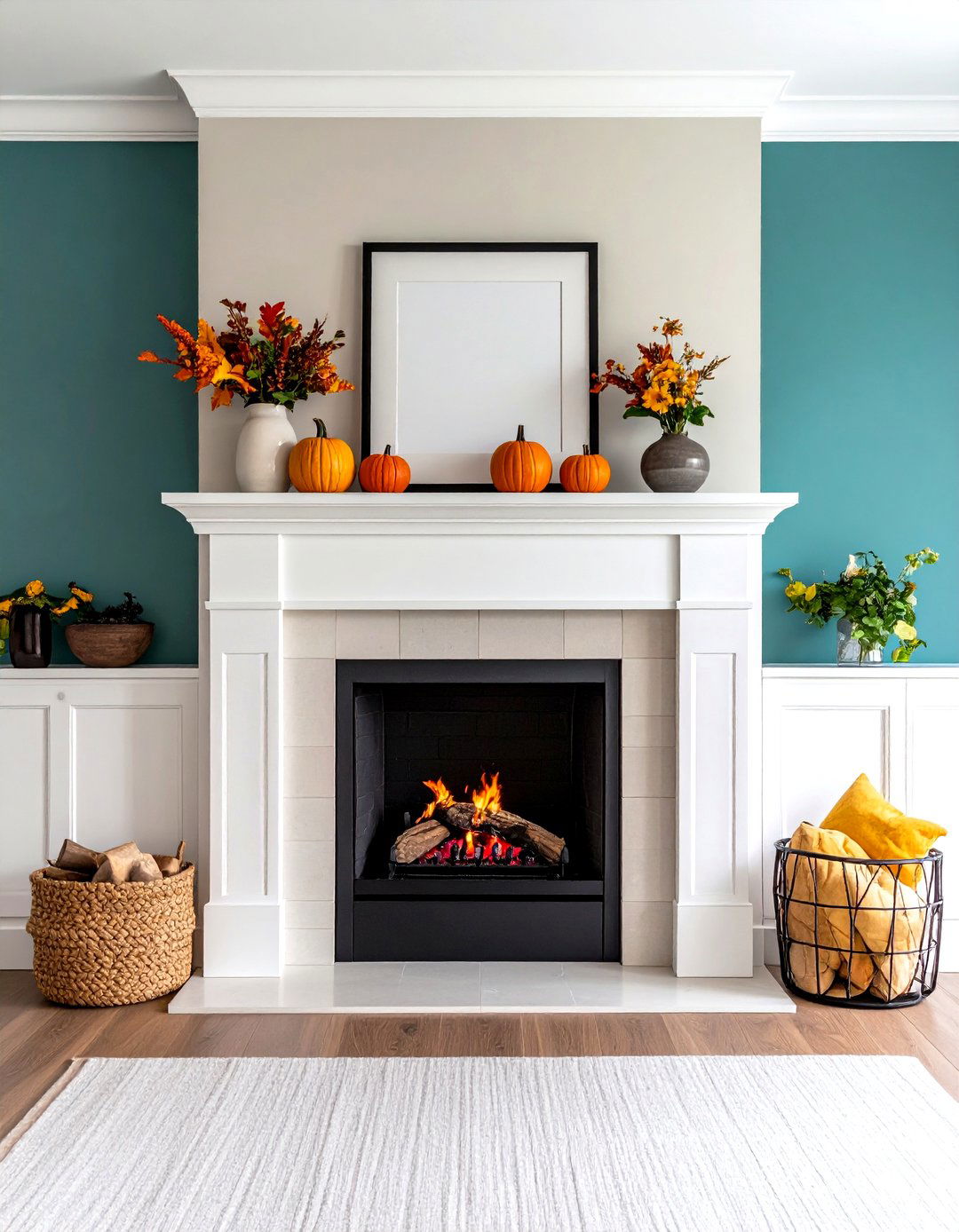
Reserve the wider side of the wall for a simple picture ledge and staggered hooks that let you rotate décor — garlands in winter, woven fans in summer — without new holes each season. A consistent change-out routine keeps the space feeling fresh, and the intentionally active display draws attention away from alignment. Use a neutral backdrop so bold seasonal pieces pop, and your off-center fireplace becomes a year-round showcase.
Conclusion:
An off-center fireplace isn’t a flaw — it’s an invitation to push past symmetry and craft layered, character-rich rooms. Whether you add storage, metalwork, greenery, or tech-forward inserts, each idea above turns the hearth’s quirk into a visual highlight while improving function and flow. Embrace the imbalance, repeat materials thoughtfully, and let clever lighting, art, and furniture layouts guide the eye; soon that supposedly “awkward” fireplace becomes the beating, design-forward heart of your home.


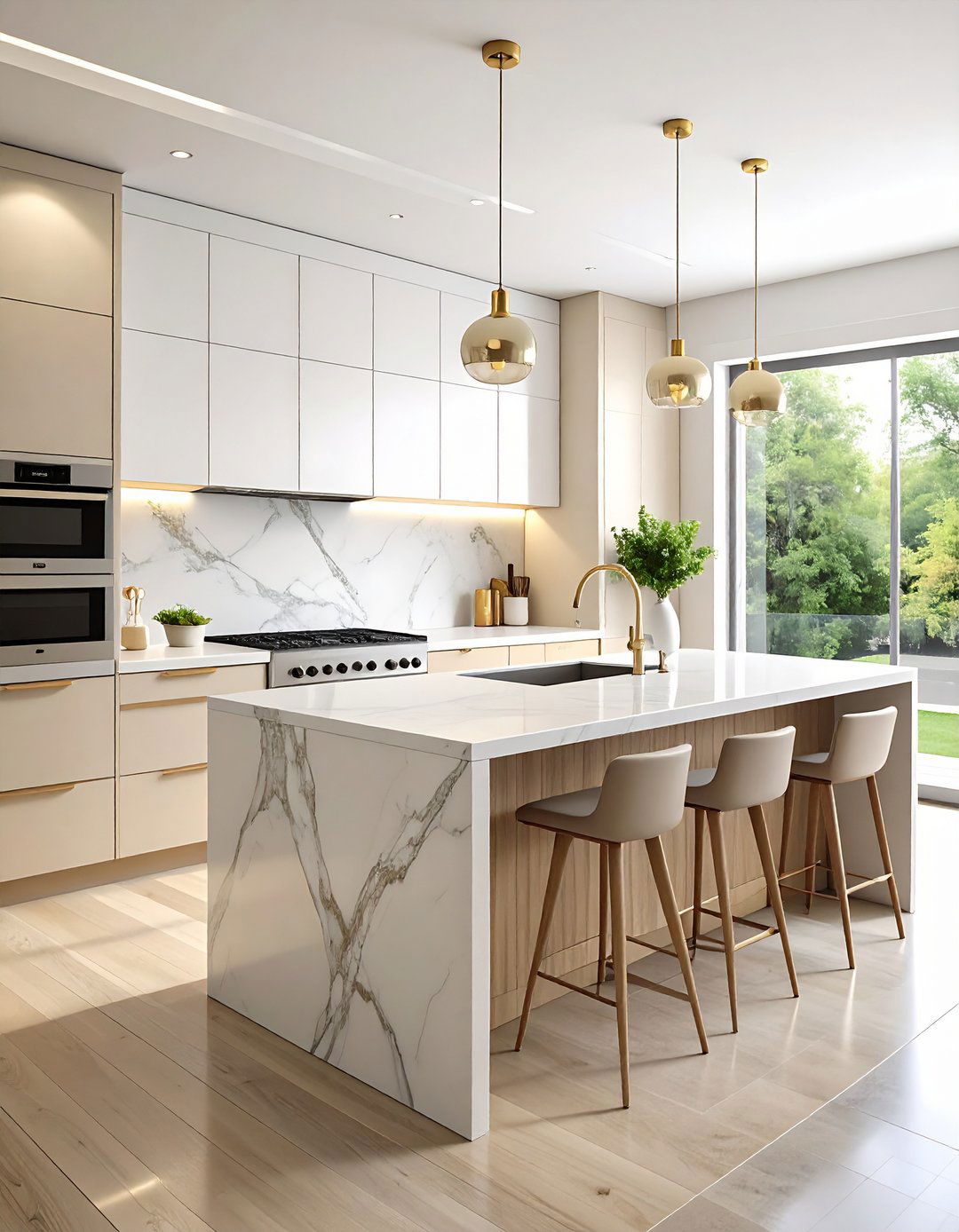
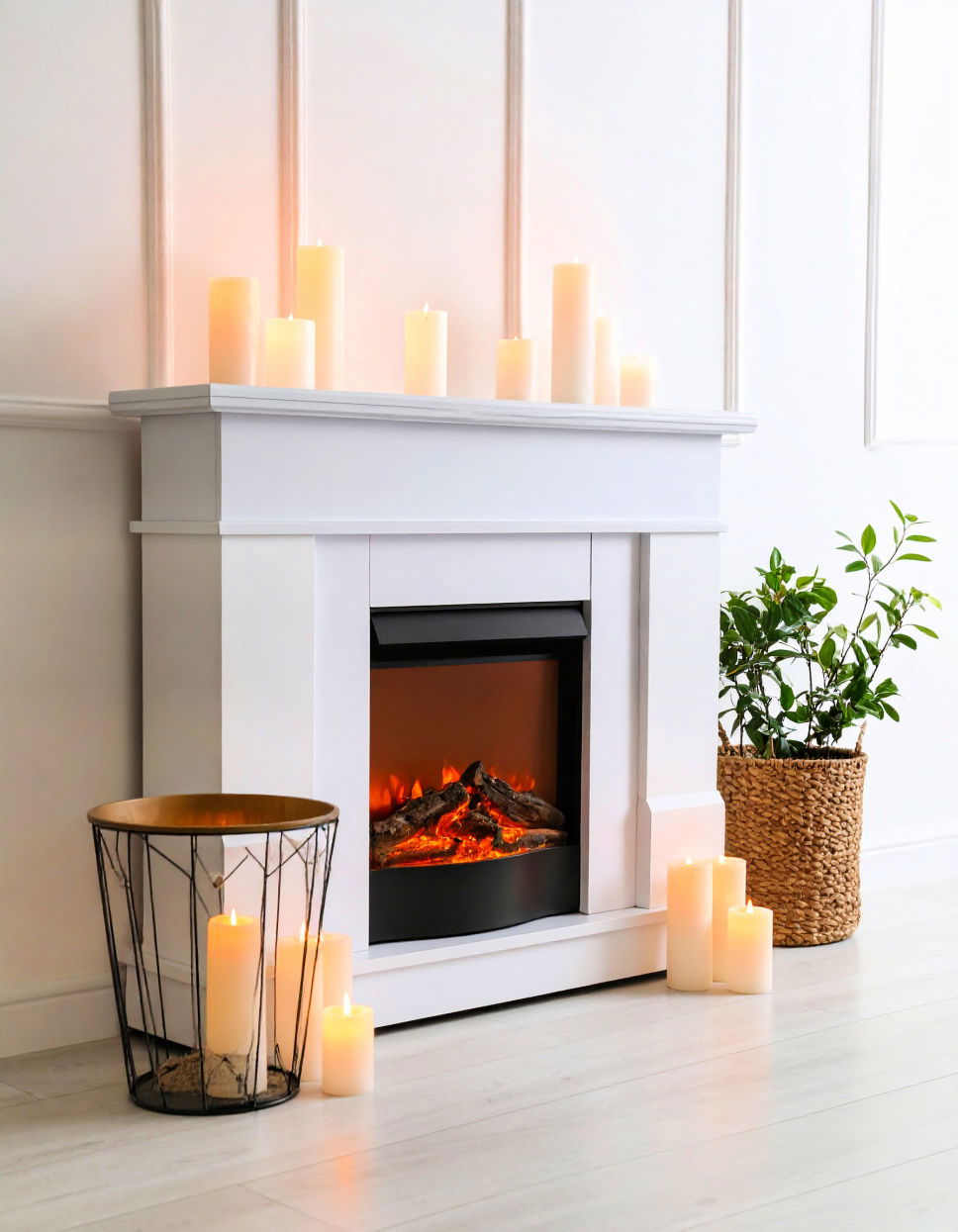
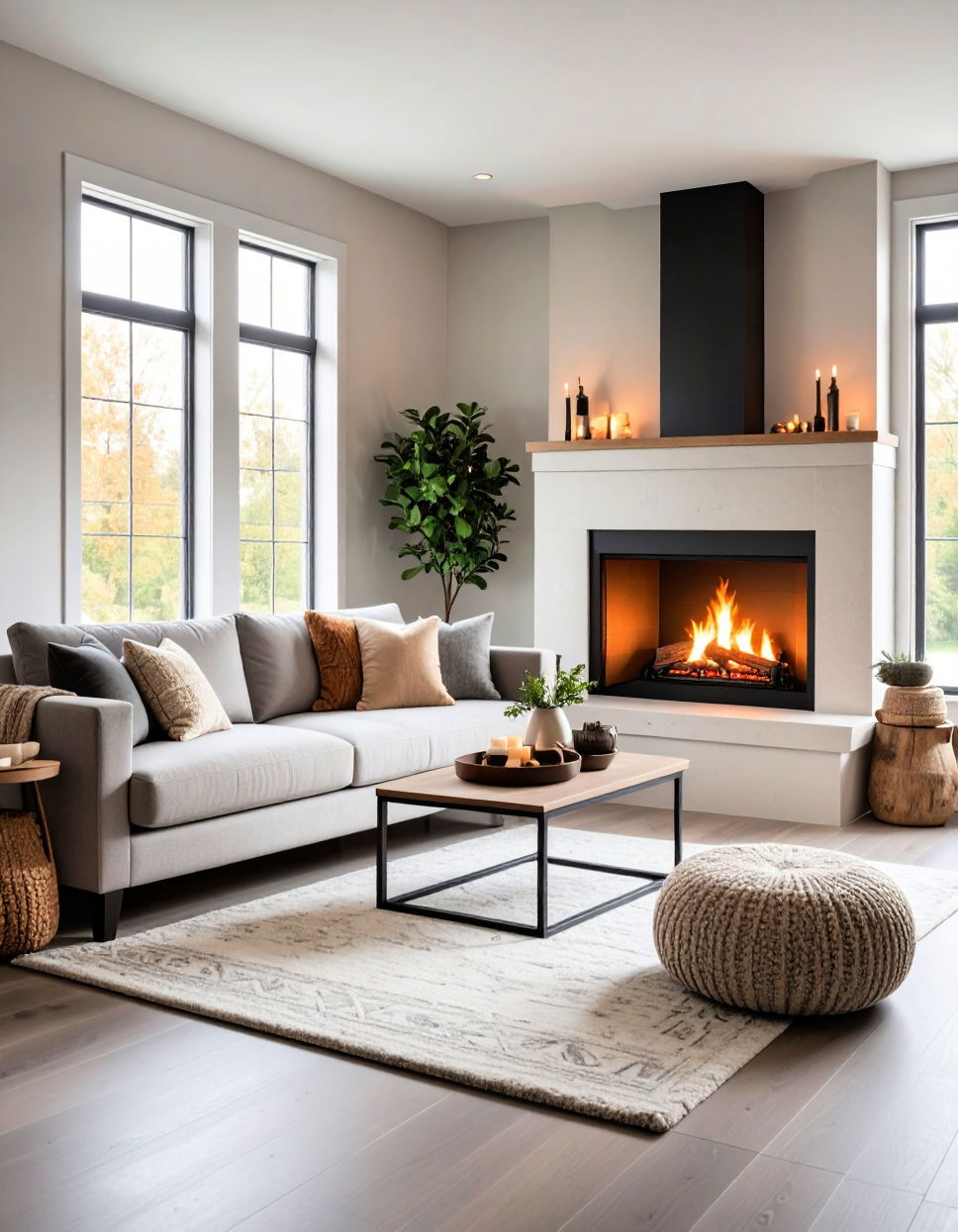
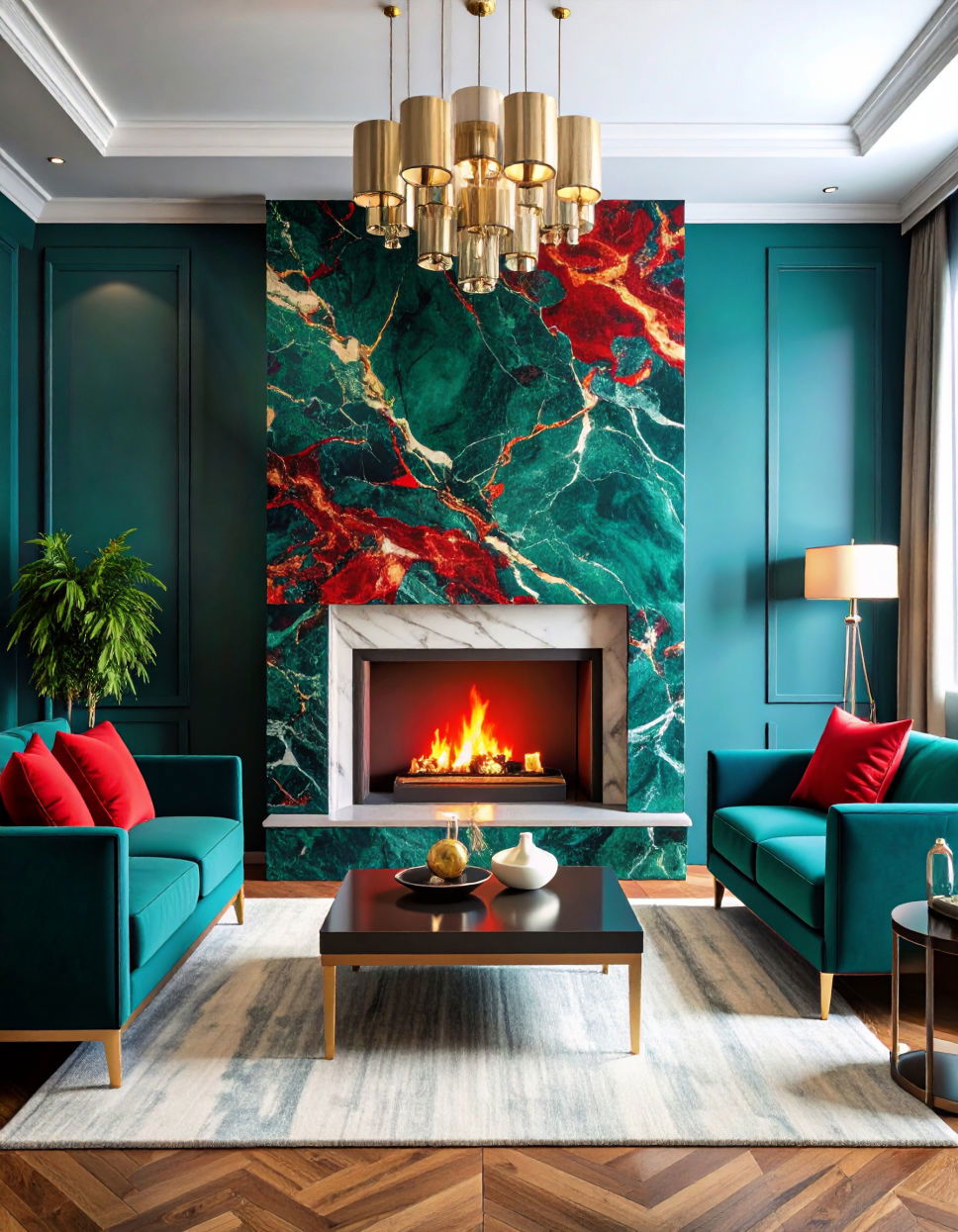


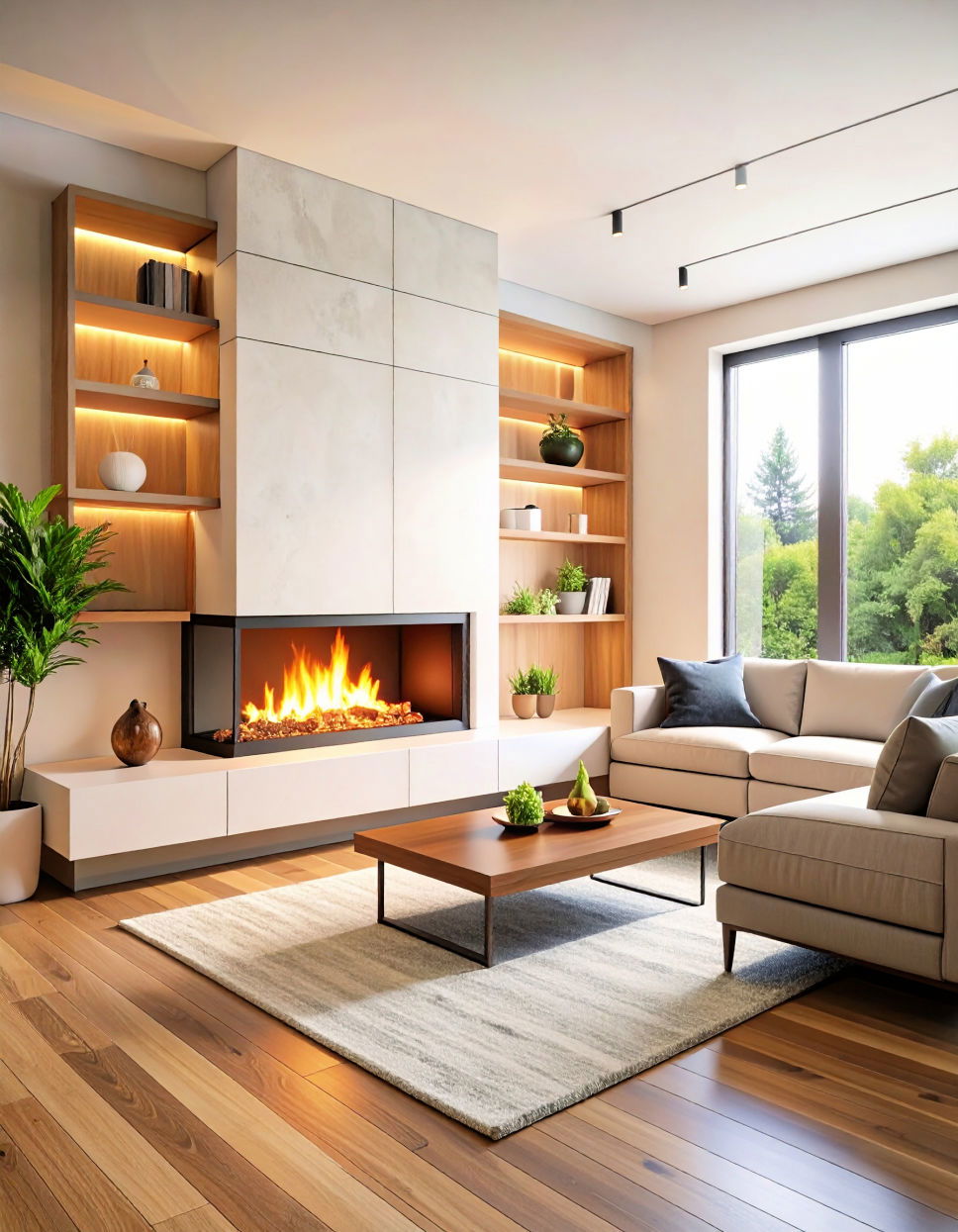
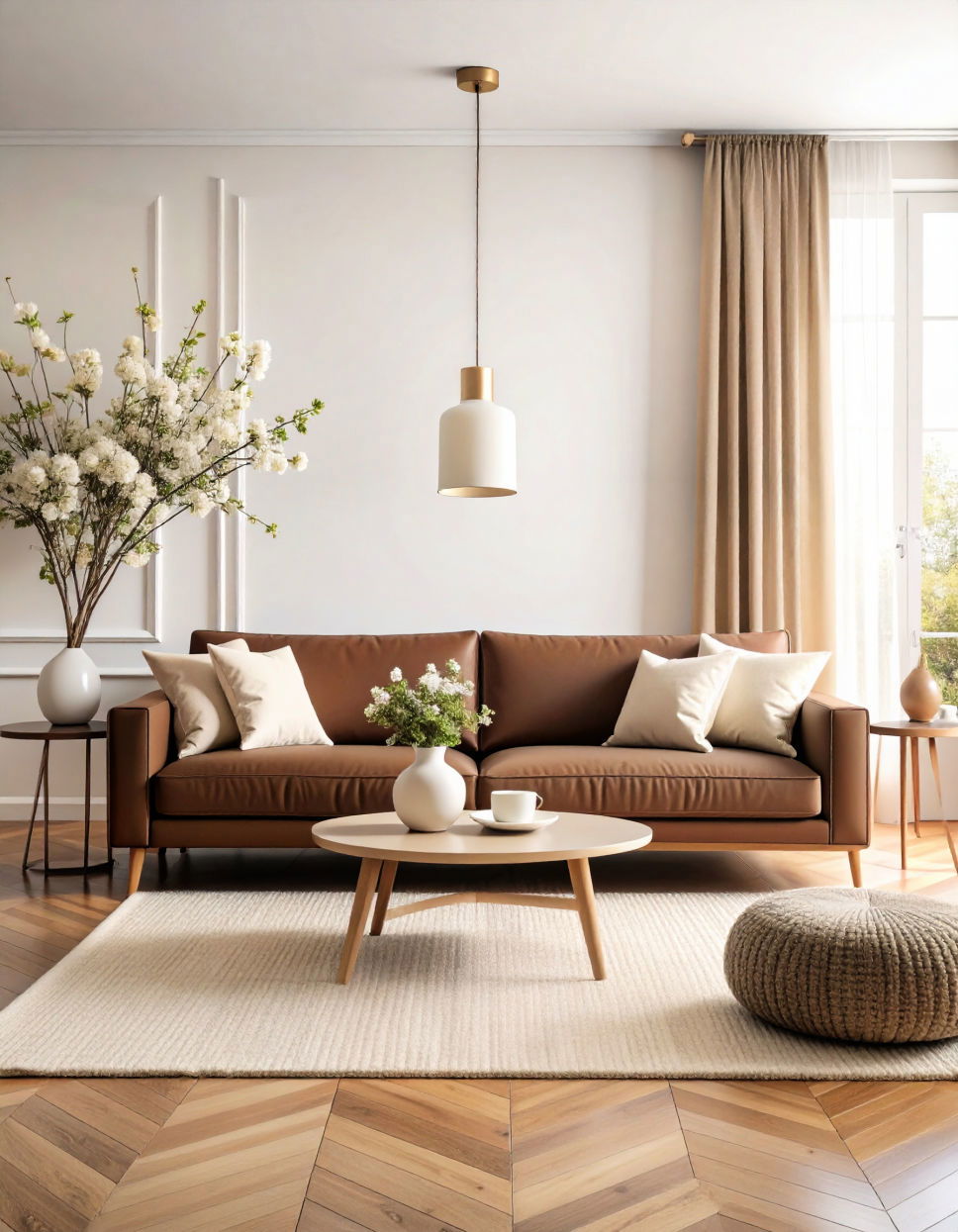
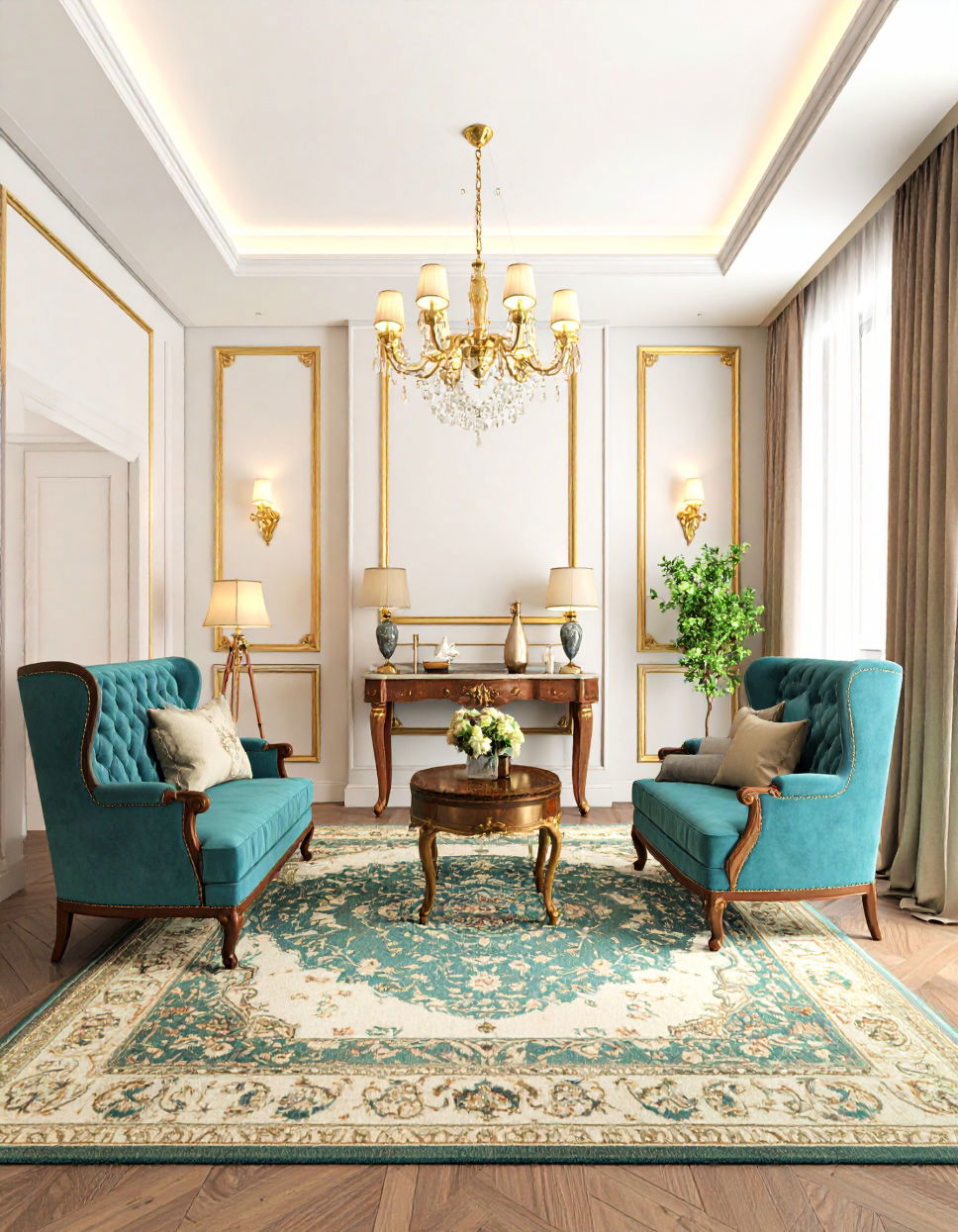

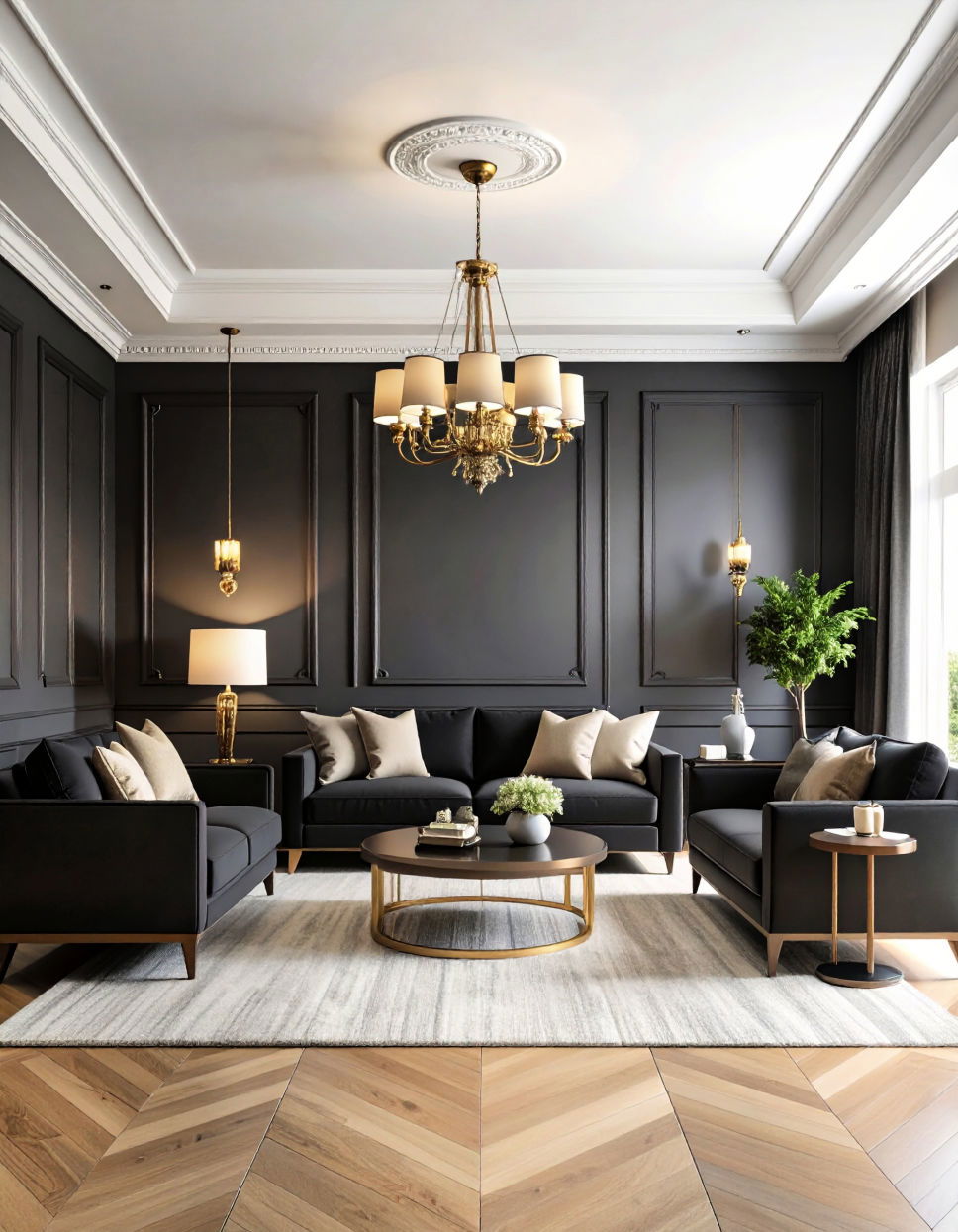
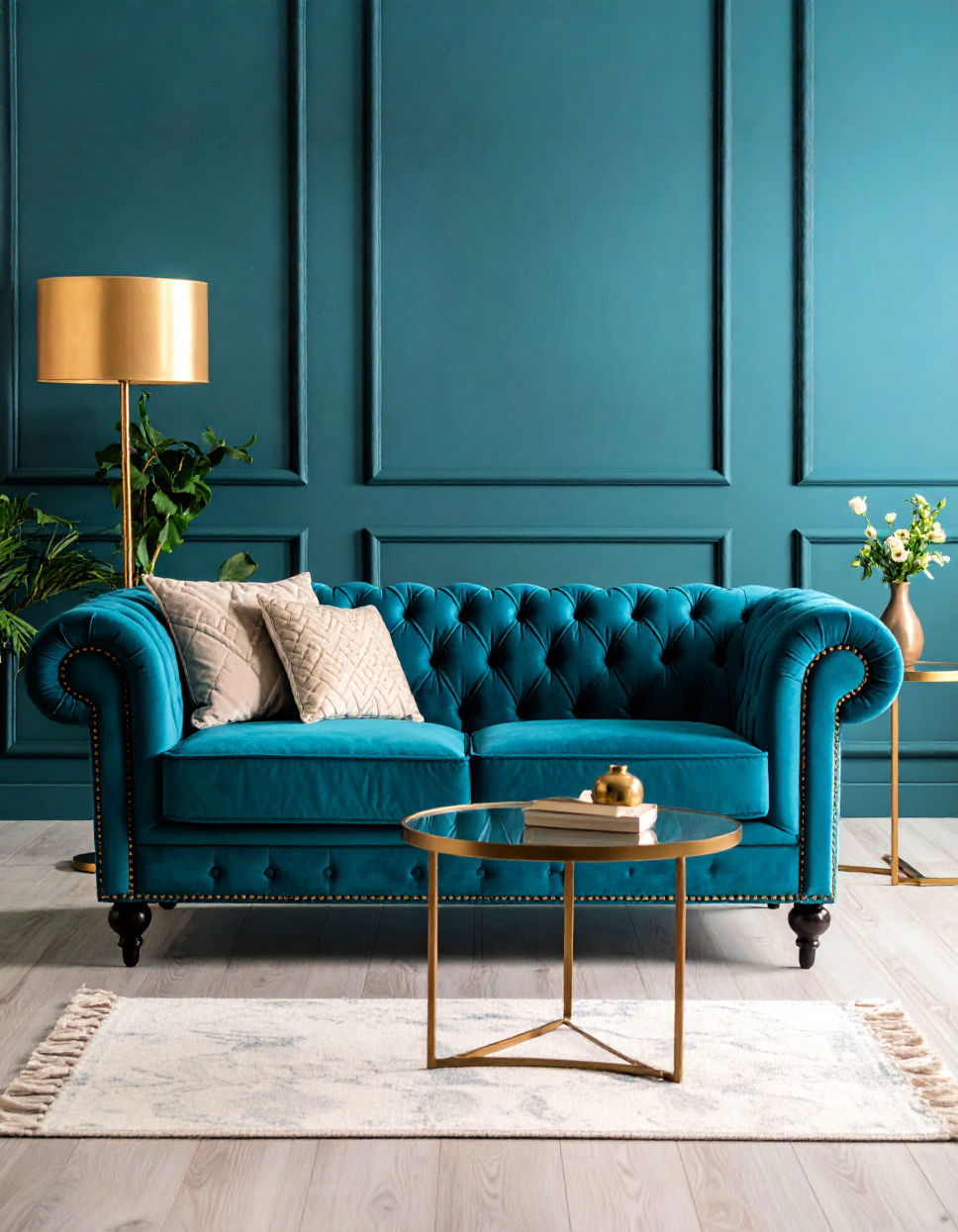
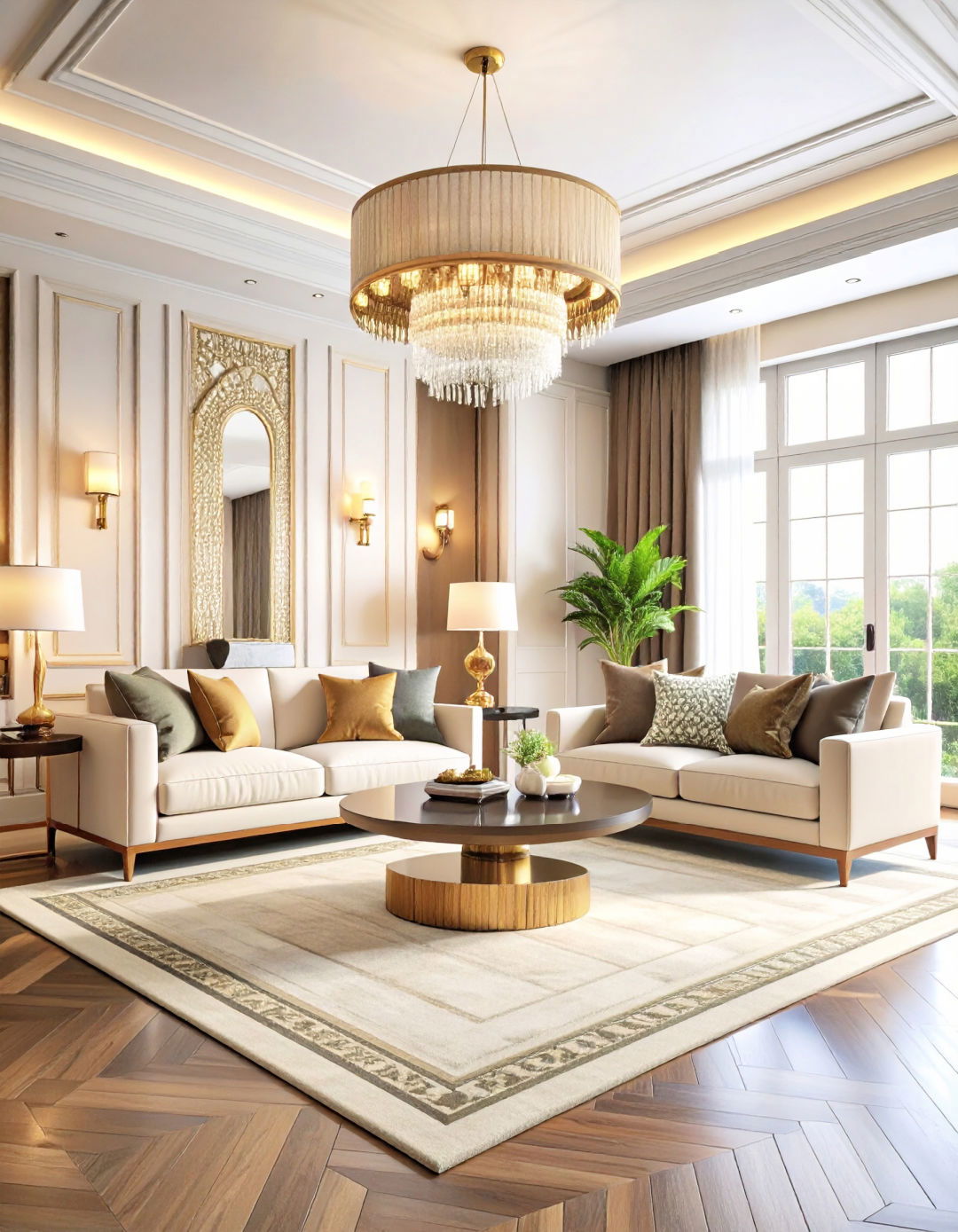
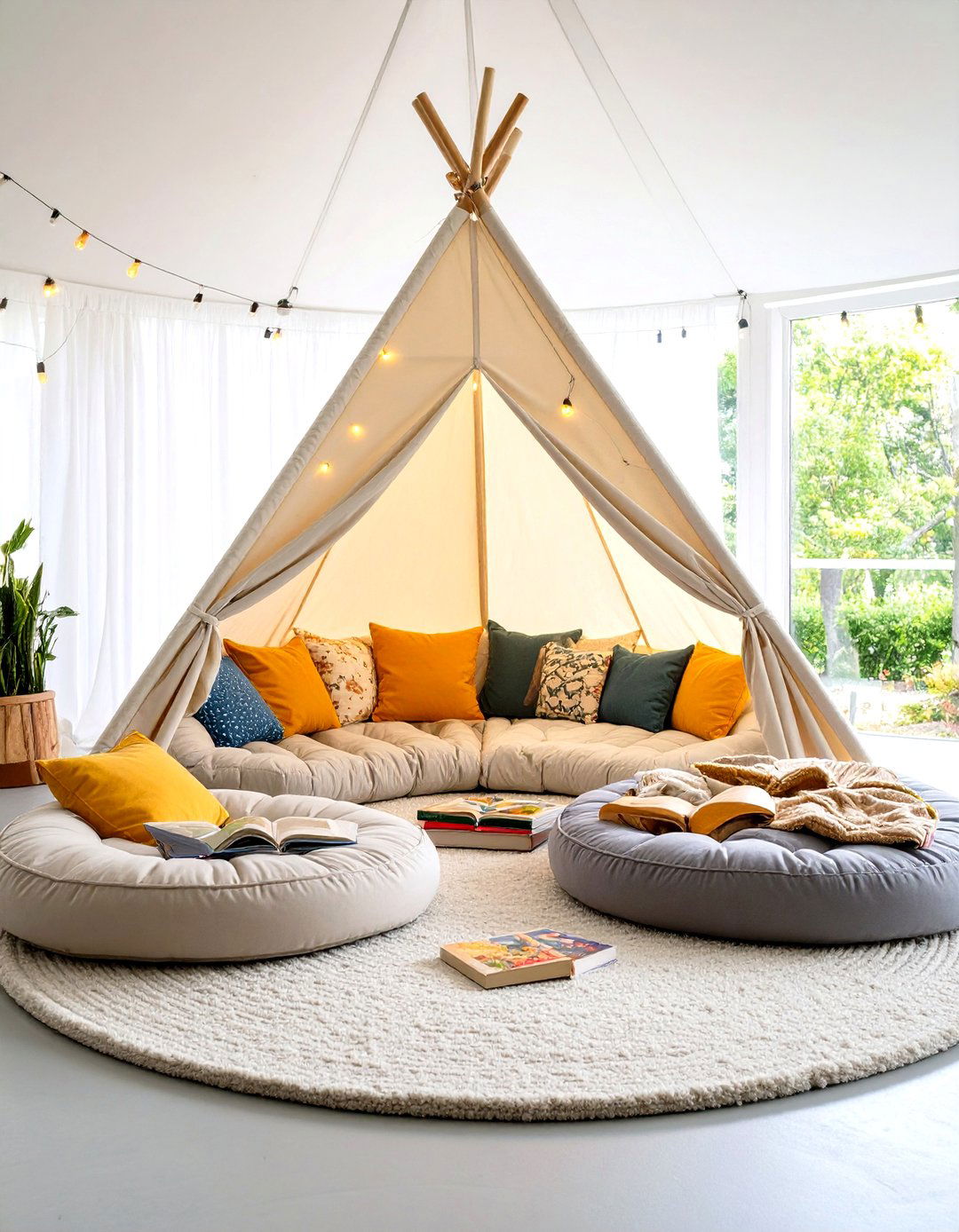
Leave a Reply